
Implementation of biosecurity measures in breeders and the hatchery
Case report of E. meleagrimitis infection in turkeys
Comprehensive study concludes chicken embryo pain perception starts on day 13th of incubation 4
2016 2024 Zootecnica International − April 2024 –POSTE ITALIANE Spa –Spedizione in Abbonamento Postale 70 %, DCB Firenze

The new feeders of the «Gió» range, specifically developed for great poultry farms, thanks to the easiness in the regulation of the feed and to the absence of grill (that avoid chicks perching) have many advantages: they are easy to use and their cleaning is extremely easy and fast too, leading to an overall reduction in labour costs.



CODAF Poultry Equipment Manufacturers • Via Cavour, 74/76 • 25010 Isorella (Brescia), ITALY Tel. +39 030 9958156 • Fax: +39 030 9952810 • info@codaf.net • www.codaf.net
EDITORIAL

As I reflect on my over fifty years of experience in the poultry sector, I am compelled to document the remarkable evolution and advancements that have shaped this industry.
In the 1960s and 1970s, research was concentrated on the production of laying hens and rapid growth of broilers. In subsequent years, selection programs aimed to meet changing consumer needs. This journey has been demanding, even though advancements have occurred rapidly in technical-scientific terms. Veterinary sciences have contributed greatly: just think of the research carried out on Newcastle disease, coccidiosis, Marek’s disease and Avian Influenza... Clearly, we need to remember many other disciplines, from nutrition to all the technologies applied in hatcheries, farms, slaughtering and processing, to underline the great merit of having placed poultry farming at the top of the food industry.
From the selection of pedigree lines in breeding farms, with trap nests and individual cages, we have moved on to genomic selection, which can improve disease resistance and productivity developed by genetics while meeting the diverse needs of various markets.
I do not hide a certain sense of pride at having witnessed this intense period of time and at having tried to provide information as correctly as possible.
BREEDAZA THE RATIONING SYSTEM FOR BROILER BREEDERS AND
LAYERS
Leader in livestock feeding systems



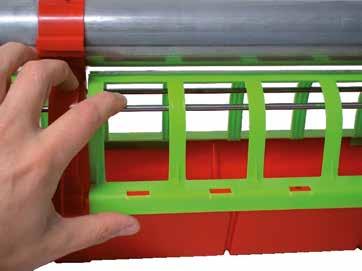
ADJUSTABLE ANTI-COCK GRID

NO OBSTACLE INSIDE
EASY ACCESS TO FEED
System designed for equal, controlled and immediate distribution throughout the line.
The obstacle-free linear trough feeder allows an easy access for the animals which can easily spot the feed.
Easy cleaning and no residual feed inside the trough.

QUALITY MADE IN ITALY www.azainternational.it
VIDEO
I WANT AZA!
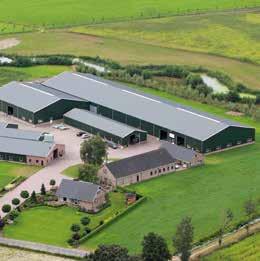


SUMMARY WORLDWIDE NEWS ......................................................................... 4 COMPANY NEWS 6 REPORTAGE Implementation of biosecurity measures in breeders and the hatchery ............. 8 FIELD CASE Case report of E. meleagrimitis infection in turkeys 12 DOSSIER Comprehensive study concludes chicken embryo pain perception starts on day 13th of incubation 18 FOCUS Organic acids as feed additives: pros and cons ............................................. 22 MANAGEMENT Amino acid imbalances 24 Does smothering occur in rearing? .................................................................. 28 NUTRITION Influence of dietary CP, dietary SID Lys and amino acid production origin on performance and global warming potential of broilers 30 Can a saponin-aluminosilicate blend promote resilience to coccidiosis in broilers? 34 VETERINARY Research shows vertical transmission of Salmonella Reading in breeders 38 Necrotic enteritis in broiler chickens 40 MARKET GUIDE 44 UPCOMING EVENTS 47 INTERNET GUIDE ............................................................................48 18 12 8
FAO meeting report - Measures for the control of Campylobacter spp. in chicken meat
The Joint FAO/WHO Expert Meeting on Microbiological Risk Assessment (JEMRA) convened a meeting in Rome, Italy from 6 to 10 February 2023, to collate and assess the most recent scientific information relevant to the control of thermotolerant Campylobacter species C. jejuni and C. coli in broiler production and chicken meat.

The scope was focused on aspects of broiler primary production from the point of chick placement into production establishments to consumer handling. The objectives were to identify and assess control measures for Campylobacter in the broiler production chain. The expert committee reviewed the available data on Campylobacter control including scientific literature published from 2008 to October 2022 and data submitted in response to a call for data for this meeting.
The experts: 1) determined the quality and quantity of evidence of con -
trol measures for Campylobacter, 2) evaluated the impact of measures to control Campylobacter in the broiler production chain, 3) determined which hazard-based interventions pertained specifically to Campylobacter and which were general to the control of foodborne pathogens in the pre- and post-harvest broiler production chain, and 4) reviewed and recommended revisions to the Guidelines for the Control of Campylobacter and Salmonella in Chicken Meat (CXG 78-2011), paragra phs 1 to 115, based on the currently available scientific evidence (Annex 3).
Control measure evaluation began at the time of chick placement since there is currently no evidence that parent flocks or hatchery practices contribute to the colonization of broiler chicks. The available literature on interventions was predominantly based on laboratory and pilot studies, with few commercial scale applications; therefore, limited conclusions could be reached. The experts recommend the use of a combination of multiple interventions (multihurdle approach) suitable to production and processing stages to lower Campylobacter contamination on chicken meat. Several interventions were identified through primary production to post-processing stages.
Available evidence for the reduction of Campylobacter was primarily focused on C. jejuni and C. coli Interventions aimed at foodborne pathogens such as irradiation or thorough cooking are effective in eliminating Campylobacter on meat. Hazard-based interventions, good agriculture practices and hygienic practices for the general control of foodborne pathogens may be effective for the reduction of Campylobacter. There are no interventions that specifically control Campylobacter on meat. The experts recognize further data gaps exist and that new technologies may offer promising approaches to reducing Campylobacter on chicken meat. Further global changes to the industry, the growth of global populations, climate change, and increased demand for animal protein in specific regions will guide the need for further control measure assessments.
Source: FAO & WHO. 2024. Measures for the control of Campylobacter spp. in chicken meat – Meeting report. Microbiological Risk Assessment Series, No. 46. Rome. https://doi. org/10.4060/cc9607en
4 - worldwide newsWORLDWIDE NEWS
46 MICROBIOLOGICAL RISK ASSESSMENT SERIES ISSN 1726-5274
Measures for the control of Campylobacter spp. in chicken meat Meeting report
Avian Influenza: Commission will give €46,7 million to Italy to compensate farmers
Following a positive vote by Member States, the Commission will provide €46,7 million to Italy to help compensate farmers in areas affected by outbreaks of Avian Influenza. Financed by the agricultural reserve, the payments must be made to farmers by 30 September 2024.
Between 1 January 2022 and 30 April 2022, 23 outbreaks of highly pathogenic Avian Influenza of subtype H5 were confirmed and notified by Italy. The species affected were chickens, laying hens, turkeys, ducks and Guinea fowls. Italy immediately and efficiently took all the necessary animal health and veterinary measures, including control, monitoring and preventive measures. Protection and surveillance zones were established. This led to a loss of production of hatching eggs, table eggs and live animals in the farms located in those areas under movement restrictions, as well as losses due to destroyed and downgraded eggs and meat.
Following a formal request by Italy, the Commission de cided, after thorough analysis, to cover with EU funds 50%
of the expenditure borne by Italy to support concerned farmers seriously affected in areas under movement restrictions due to outbreaks of Avian Influenza. A total of €46 670 790 from the agricultural reserve will be provided. This amount was established on the basis of set compensation amount per animal and egg.
Only farms located in those regulated zones and affected by the control measures caused by the 23 mentioned outbreaks will be entitled to receive this support. To avoid
DRINKING FOR TURKEY
Consisting of a system with the pendulum as the main element, which ensures a perfect water supply at all times.

• The pendulum is activated every time the animal moves it with its head to drink.

• The new pendulum with two nipples guarantees even grater reliability of the drinker, both in terms of durability and ease manintenance.
• Cleaner litter and the best results in both the rearing and finishing phases at every age of the turkey.


EASYLINE 2.0
Original! The Via Marco Polo, 33 - 35011 - Campodarsego (PD) ITALIA +39 0499202290 - lubingsystem.com - info@lubing.it - april 2024 - 5 WORLDWIDE NEWS
VDL Jansen introduces VacuMite: your red mite’s worst enemy!
VDL Jansen, a leader in innovative poultry farming solutions, unveils VacuMite, a groundbreaking tool designed to address the persistent challenge of red mite infestation in cage-free egg production.

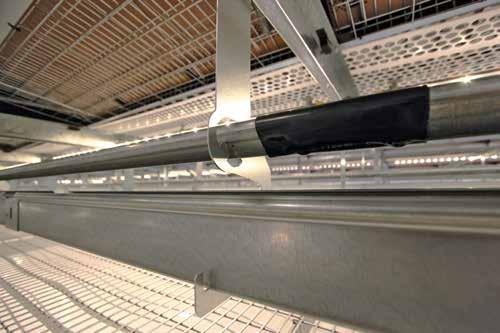
Modern poultry farming comes with its own set of challenges, and one of the major concerns is the prevalence of red mites. In response to this issue, VDL Jansen has engineered VacuMite, an eco-friendly and animal-conscious solution that sets a new standard in the battle against red mite infestations.
VacuMite operates on a unique and efficient principle. Specially designed perches with tiny holes create an environment where mites gather during the night. During the day, VacuMite systematically extract mites from their hiding spots with an air flow that is created by an under pressure in the perches, depositing them into a central
collection bin in the technical room. This innovative approach not only ensures the welfare of laying hens but also supports farmers in maintaining control over red mite populations, ultimately enhancing the overall work experience for farmers.
VacuMite is designed exclusively for use with VDL Jansen’s Comfort 2.0 and Comfort 2.0INSIDE aviary systems, ensuring optimal performance and ease of integration. It is possible, when building the aviary system, to prepare it for placing and installing the VacuMite system at a later time.
Key features of VacuMite
• Improving bird welfare
• Mechanical system without chemicals
• Maintenance friendly solution
• Programmable start times
• One-time investment
• Proven effectiveness, measurable results
• Mites are deactivated during extraction
• Selfcleaning filter (mites are seperated automatically)
• Optional connection to climate computer
The first projects with VacuMite have recently been installed, and the system was officially released during the recent LayerTech summit, that VDL Jansen organized for their dealers. VDL Jansen invites the industry to experience the benefits from firsthand, getting into contact with your local VDL Jansen dealer.
For more information:
VDL Jansen Harselaarseweg 32, Barneveld Tel. +31 (0)342 427000
Website: www.vdljansen.com - Mail: info@vdljansen.com

6 - company newsCOMPANY NEWS



Aviagen Advantage Welfare


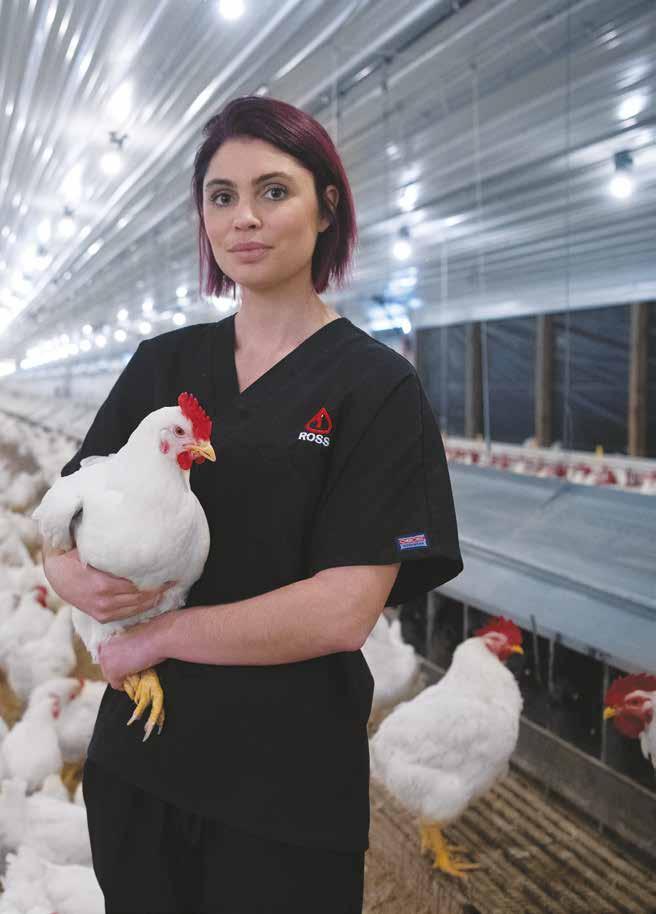

We are a champion of bird welfare. Through balanced breeding, the health, livability and robustness, combined with performance and feed efficiency, provide a sustainable bird with strong welfare and viability. Learn more at Aviagen.com.
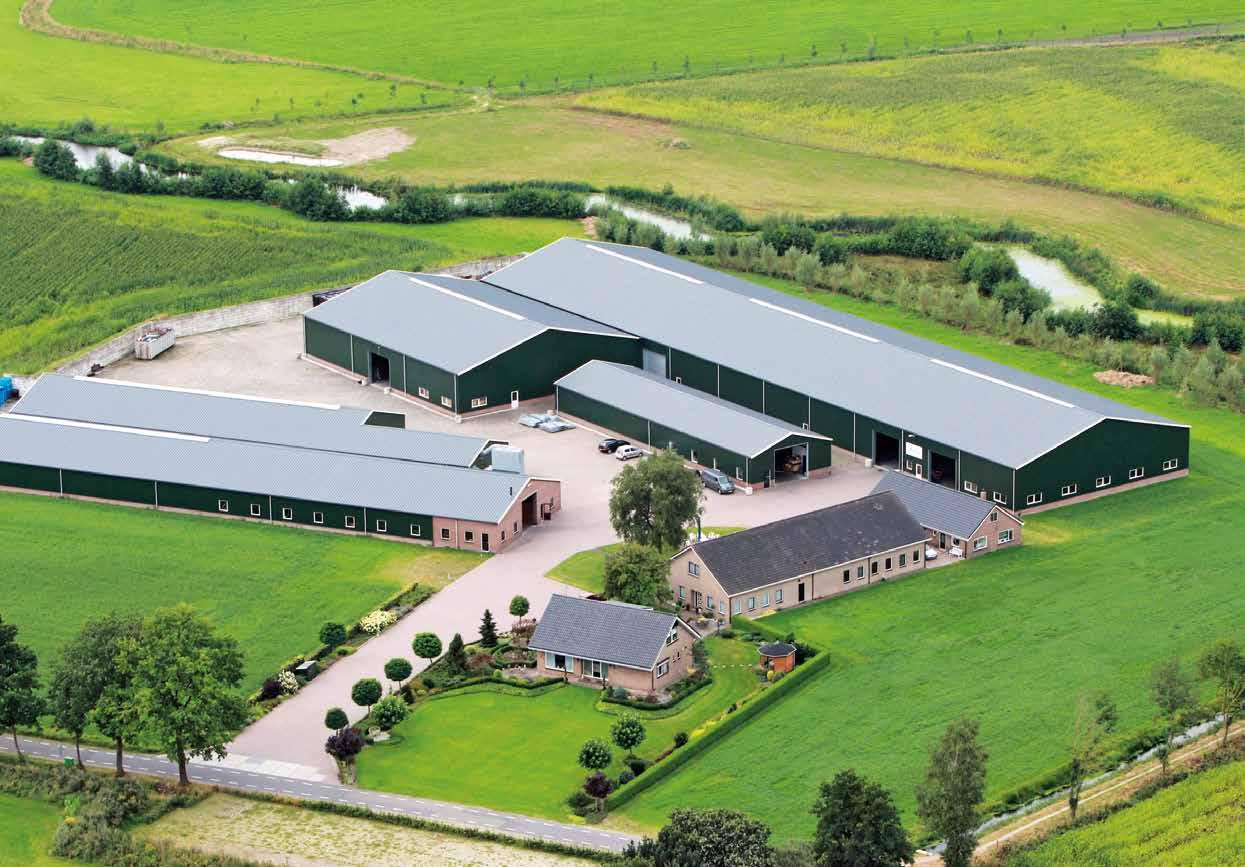
Implementation of biosecurity measures in breeders and the hatchery
Giuditta Tilli1, Emanuele d’Erasmo2, Carlo Castellina3, Alessandra Piccirillo1
1 Department of Comparative Biomedicine and Food Science, University of Padua, Viale dell’Università 16, Legnaro, 35020 Padua, Italy
2 Aviagen Italia srl, Via Salvo D’Acquisto 27, Cocconato, 14023 Asti, Italy
3 Gruppo Aglietto Natura srl, Viale Roma 9, Bianzè, 13041 Vercelli, Italy
Biosecurity measures represent a powerful prevention tool, that should be implemented regularly at each level of the production chain in livestock farming. Thus, referring to poultry, biosecurity should be properly implemented in all the steps, such as hatcheries and slaughterhouses as well as in the farms themselves. Given the role they have, breeder farms and hatcheries are usually well known for their higher biosecurity levels. However, some gaps and critical points could be present even in such facilities. Within this article, the purpose is to point out some biosecurity practices of both breeder farms and hatcheries.
8 - reportageREPORTAGE
Main insights show that concerning breeder farms, the three most important biosecurity features are: proper management of breeders, good quality of hatching eggs, proper collection and storage of hatching eggs, since the following step in the production chain is the hatchery. While concerning hatcheries, biosecurity lies on three fundamental aspects: hatching eggs, facilities and workers. The latter is the trickiest to manage, but also the most important since biosecurity heavily depends on the workers’ behaviors and cannot be underestimated.

Figure 1 – Schematic representation of the vertically integrated poultry production system. Image created by the Digital Learning and Multimedia Office (© University of Padua) within the framework of the “NetPoulSafe” project. This project was funded by the European Union, Horizon 2020 program for research and innovation, Grant Agreement n. 101000728 (NetPoulSafe). For more information: www.netpoulsafe.eu.
In poultry production, biosecurity in farms represents the main prevention tool and, according to the World Organization for Animal Health (WOAH) it is defined as “ the sum of management and physical measures designed to reduce the risk of introduction, development and spread of diseases to, from and within an animal population ”.
Ideally, the application of such measures should pass through each step of the poultry production chain, considering all the different animal populations: the eggs in the hatchery, the flock on the farm, the animals intended for slaughter in the slaughter plants.
Each level is different from the other and so are the risks that are to be prevented with correct implementation of biosecurity measures. This means that biosecurity must be designed on the basis of the population to protect. This is why usually, being at the top of the poultry production chain, biosecurity measures in breeding farms and hatcheries are notoriously higher than in production farms. However, even these structures and types of farming can present flaws in the biosecurity system.
The objective of this technical article is to point out some biosecurity measures to be applied in the breeding phase and in the hatchery. The contents of this article are based on a webinar organized within the European project NetPoulSafe - Networking European poultry actors for enhancing the compliance of biosecurity measures for a sustainable production (G.A. 101000728), during which Dr. Emanuele D’Erasmo and Dr. Carlo Castellina talked about this topic.
The impact of biosecurity on the hatching egg quality
In breeding farms, the final product is the hatching egg, which will then move to the next phase of poultry production chain, the hatchery. Therefore, in order to avoid the spread of health problems from one level to another, great attention must be paid to the management of hatching eggs. In particular, the attention should be focused on:
1. animal (breeders) health management
2. quality of hatching eggs
3. collection and storage of hatching eggs.
Starting from the management of animal health (1), the most important concept is: diseases must not enter
- april 2024 - 9 REPORTAGE

the breeding farm because some can be transmitted to the offspring. Taking this as a fixed point, it is necessary to comply with structural requirements of farms and behavioural rules for workers.
Moving forward, the basis for a good quality of hatching eggs (2) is a good eggshell quality and an adequate laying area. Dirty and rough-shelled eggs should be discarded or incubated separately, therefore they should be handled properly.
Regarding the collection and storage of hatching eggs (3), attention must be paid to the handling of eggs from laying to the start of incubation. In particular, hands’ sanitization before and after egg collection and during egg selection is critical. Regarding storage, it is necessary to avoid temperature changes and stratification inside the egg storage rooms, and choose dry disinfection systems before incubation.
Practical biosecurity in the hatchery
Following the laying phase, the egg incubation phase begins. It occurs in the hatchery and its final product is the chick.
To obtain good quality chicks it is necessary to implement biosecurity measures on:
1. hatching eggs
2. facilities
3. personnel
through an integrated approach involving the workers in the hatchery as well.
If intervening on the biosecurity of hatching eggs (1) and facilities (2) is easily feasible, interventions on personnel (3) are more complex to manage but at the same time essential since biosecurity relies firmly on people and their behaviour.
Intervening on staff involves numerous “unknowns” (having to deal with the “human factor”): a possible method to achieve the final objective is to create an awareness of biosecurity in all workers of the hatchery.
But what is biosecurity awareness? In other words, if the staff knows “what” to do in terms of biosecurity, and, above all, “why”, it will be possible to achieve the biosecurity purposes.
How do you create biosecurity awareness? Here, some tips:
• establish a common objective (ensure biosecurity)
• work on the emotional component of people (establish solid relationships)
• share and disseminate information.
Do you want to know more? Watch the webinar of the event, available on YouTube at the following link: https:// www.youtube.com/watch?v=iSQGLr9-Pr4

For more information go to the website www.netpoulsafe.eu: you will find many other multimedia and non-multimedia contents regarding biosecurity in poultry farming!
10 - reportageREPORTAGE
Figure 2 – Detection of egg temperature in hatchery.

Sanitary Box
Professional, heavy-duty, insulated box for use on farms. Easy to transport and designed to comply with the health rules.
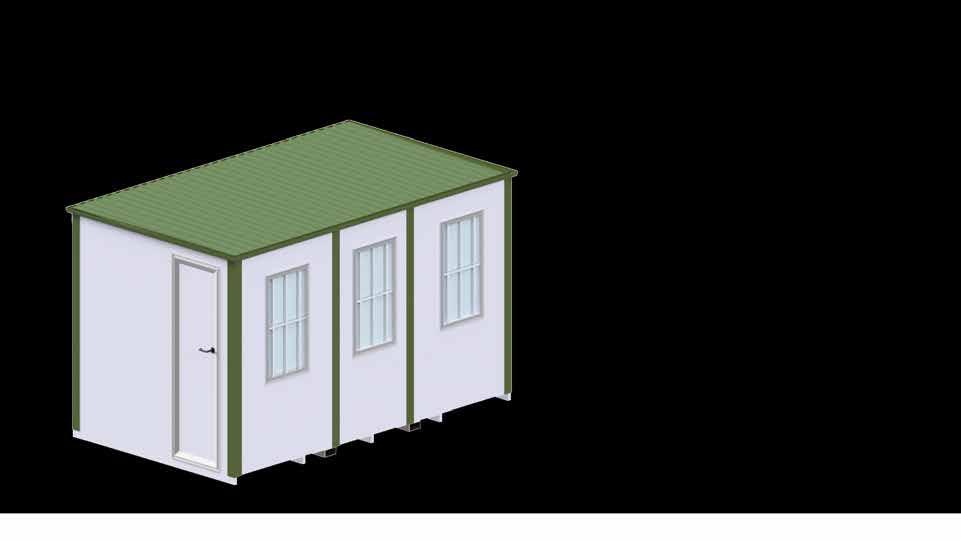
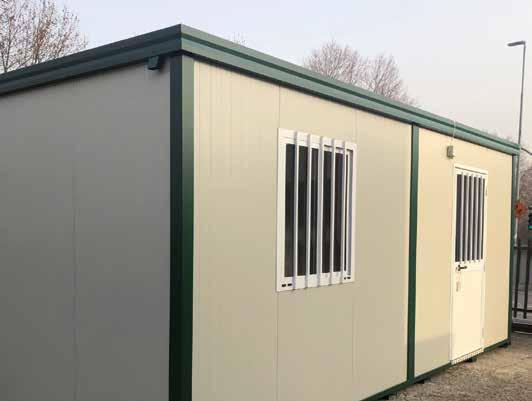


4 boxes in one full truckload
Agritech s.r.l.
Via Rimembranze, 7 25012 Calvisano (BS) Italy
Tel. + 39 030 9968222 r.a. Fax + 39 030 9968444
commerce@agritech.it www.agritech.it


Case report of E. meleagrimitis infection in turkeys
Vijay Durairaj1, Steven Clark 2 , Emily Barber1 and Ryan Vander Veen1
1 Huvepharma, Inc., Lincoln, Nebraska, USA.
2 Huvepharma, Inc., Peachtree City, Georgia, USA.
Corresponding author: Vijay.Durairaj@huvepharma.us
Intestinal health serves as a baseline for raising healthy turkeys. Any compromise to the intestinal health negatively impacts the growth and production of turkeys and adversely affects their profitability. Coccidiosis in turkeys is caused by Eimeria species which pose a substantial risk to the turkey industry. Turkey coccidiosis is controlled by feed administration of anticoccidials and phytogenic products or vaccination of turkey poults.
Seven Eimeria species have been described in turkeys and each Eimeria species targets specific regions of the intestine. In field conditions, turkeys consume sporulated oocysts in the litter, which replicate and then numerous unsporulated oocysts are shed in the feces. The oocysts shed in the feces may be screened at regular intervals to monitor the oocyst load in turkey barns.
12 - field caseFIELD CASE
Surveillance of Eimeria species in the turkey flock helps in understanding the oocyst load as well as to speciate the circulating strains on farm premises. In February 2023, an increased number of oocysts were detected in 30-dayold turkeys raised in two conventional barns (Barn A and B), USA. As a part of the field investigation, a few turkeys were necropsied and studied. Although gross lesions were noticed in few birds from Barn A, most of the turkeys in both barns did not have any gross lesions associated with coccidiosis. On mucosal scraping, Eimeria oocysts were detected in both barns and confirmed as E. meleagrimitis by PCR and sequencing.
Introduction
Maintaining intestinal integrity is one of the top goals for raising healthy turkeys. Coccidiosis is a common protozoal disease impacting intestinal health. Eimeria species are non-flagellated protozoan parasites that are ubiquitous in intense poultry rearing operations and is the causative agent for coccidiosis. Eimeria species are host specific in nature and seven Eimeria species have been described in turkeys. The seven Eimeria species include E. adenoeides, E. meleagrimitis, E. gallopavonis, E. dispersa, E. meleagridis, E. innocua and E. subrotunda Each Eimeria species affects specific parts of the intestine, undergoes replication, and induces inflammation, necrosis and damage to the intestine. The intestinal inflammation adversely affects the integrity of the intestine and interferes with normal absorption of nutrients, predisposes to secondary infection, and opens a channel for the entry of the intestinal microbiota to cross the barrier and enter the host system.
Coccidiosis is spread by fecal-oral route. Turkeys infected with Eimeria shed the non-sporulated oocysts in the litter, which are non-infectious. Under optimum temperature, moisture and oxygen levels, the non-sporulated oocysts sporulate and become infectious. Turkeys consuming the sporulated oocysts becomes infected with that Eimeria species and the cycle continues. Turkey Eimeria species are prolific in nature and reproduce very quickly with a prepatent period between 4-5 days. Not all the turkeys are exposed to Eimeria at same level, it varies depending on Eimeria oocyst load in the litter as well as the management conditions. The Eimeria oocyst load could be impacted by the density of birds, season, litter management, downtime period and the immune status of turkeys.
The turkey industry follows prophylactic administration of anticoccidials, vaccination or administration of phytogenic products to control coccidiosis. Compared to the chicken industry, the turkey industry has a limited number of anticoccidials. Rotation or shuttle programs are followed by the turkey industry as an intervention strategy to prevent coccidiosis. In rotation programs, different anticoccidials/ phytochemicals are rotated between the seasons or anticoccidials/phytochemicals and vaccination are rotated between the seasons. In shuttle programs, the different anticoccidials/phytochemicals are changed between different age groups of turkeys. Due to the limited number of anticoccidials available, there are increased chances of repeating the same anticoccidials which further increases the chance of resistance against these anticoccidials.
Coccidiosis poses a threat to the turkey industry and was ranked #9 in the 2022 US turkey industry survey. The economic losses from coccidiosis are not limited to losses associated with mortalities, but also include poor feed conversion ratio (FCR), production losses, and treatment costs. The intestinal damage incurred by Eimeria predisposes birds to secondary infection resulting in further economic losses. To avoid these losses, several turkey production companies routinely follow coccidiosis surveillance programs to monitor the Eimeria strains circulating on their farm. Since infected turkeys shed oocysts in the feces, oocyst per gram (OPG) is used as a monitoring tool to understand the Eimeria load in the barn and evaluate the anticoccidial or vaccine efficacy.
Case report
Case history
In February 2023, enteritis was reported in 30-day-oldturkeys in Southeast, USA. Out of five barns, two barns (A and B) were affected and each barn had 17,761 turkeys on the day of placement. The poults were placed on new litter shavings and in-feed medication was used for coccidiosis control. The routine coccidiosis monitoring program detected an increased number of oocysts. At 30 days-ofage, necropsy was performed on a few runted birds and examined for gross lesions.
Evaluation of mucosal scrapings
The intestinal mucosal scrapings (duodenum, jejunum, ileum and ceca) were collected from the birds/ barn and
13
- april 2024 -
FIELD CASE

1 – Gross pathology lesions in duodenum and jejunum of 30-day-old turkeys (Barn A)
pooled separately. The mucosal scrapings were examined under the microscope.
DNA extraction and PCR
DNA was extracted from the mucosal scrapings by using glass beads to rupture the oocysts followed by proteinase K (Qiagen) digestion. The DNA extraction was performed by using QIAamp Fast DNA Stool Kit (Qiagen) by following the manufacturer recommendations. Each PCR reaction mix (25 µL) had 5 µL of the template along with 1x GoTaq ® G2 Hot Start Master Mix (Promega) and 0.4 µM of each primer.
Gel electrophoresis and sequencing
The amplicons (2 µl) generated from the PCR reactions were electrophoresed and visualized in E-GelTM EX Agarose Gels, 2% (Invitrogen). A reference E-Gel™ 1 Kb Plus DNA Ladder (Invitrogen) was used to identify the size of the amplicons. The amplicons were purified following the instructions using a QIAquick PCR purification kit (Qiagen) followed by submission for sequencing (Eurofins, KY).
Results and discussion
Overall, most of the turkeys examined in both barns did not have any gross lesions associated with coccidiosis. Only a few turkeys in Barn A had abnormal contents with fluid and mucoid contents in the duodenum and jejunum (Figure 1). On evaluation of the intestinal mucosal scrapes, Eimeria


–
identification of
oocysts were detected in both barns (Figures 2 and 3). In low-grade infections the pathological manifestations are not pronounced. Also, in field conditions all turkeys are not challenged at the same time and the dose varies based on oocyst consumption. PCR was performed against common turkey Eimeria species based on previously published primers. The amplicons generated from PCR reactions (Figure 4 and 5) were sequenced, analyzed and confirmed as E. meleagrimitis
The upper small intestine of turkeys is the target organ for protozoan parasites E. meleagrimitis, E. dispersa, E. subrotunda, and E. innocua. Among the Eimeria species, E. meleagrimitis is considered highly pathogenic, E. dispersa moderately pathogenic, while E. subrotunda and E. innocua are non-pathogenic.
The highly pathogenic species E. meleagrimitis targets the duodenum and upper jejunum and induces severe damage to intestinal mucosa resulting in inflammation, congestion, and edema. The normal intestinal contents are replaced with watery, mucoid, fibrinous contents and diphtheritic membrane in severe infections. The clinical signs include ruffled feathers, drooped wings, listlessness, unthriftiness, huddling and foul-smelling watery or mucus diarrhea, which may be stained with blood and appear brownish or red in color. In subclinical infections these clinical manifestations are not present. Production performance is affected in both subclinical and clinical infections, while increased mortality rates result from heavy infections.
Figure
Figure 2 – Microscopic identification of Eimeria oocysts from intestinal mucosal scrapings of 30-day-old turkeys (Barn A)
Figure 3
Microscopic
Eimeria oocysts from intestinal mucosal scrapings of 30-day-old turkeys (Barn B).
14 - field caseFIELD CASE

Figure 4 – Gel images of amplicons generated against Eimeria species primers (Barn A).
Gel 1: M- Molecular size marker (1 Kb Plus DNA Ladder); Lane 1Intestinal mucosal scraping; Lane 2- Negative control-E. adenoeides; Lane 3- Positive control- E. adenoeides; Lane 4- Intestinal mucosal scraping; Lane 5- Negative control- E. gallopavonis; Lane 6-Positive control- E. gallopavonis; Lane 7- Intestinal mucosal scraping; Lane 8- Negative control- E. meleagrimitis; Lane 9- Positive control-E. meleagrimitis.
Gel 2: M- Molecular size marker (1 Kb Plus DNA Ladder); Lane 1Intestinal mucosal scraping; Lane 2-Negative control- E. dispersa; Lane 3- Positive control- E. dispersa; Lane 4- Intestinal mucosal scraping; Lane 5-Negative control- E. meleagridis; Lane 6-Positive control- E. meleagridis; Lane 7- Intestinal mucosal scraping; Lane 8- Negative control- E. innocua.
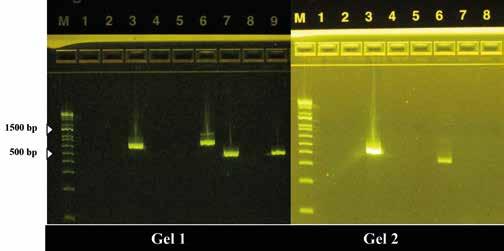
Figure 5 – Gel images of amplicons generated against Eimeria species primers (Barn B).
Gel 1: M- Molecular size marker (1 Kb Plus DNA Ladder); Lane 1Intestinal mucosal scraping; Lane 2- Negative control-E. adenoeides; Lane 3- Positive control- E. adenoeides; Lane 4- Intestinal mucosal scraping; Lane 5- Negative control- E. gallopavonis; Lane 6-Positive control- E. gallopavonis; Lane 7- Intestinal mucosal scraping; Lane 8- Negative control- E. meleagrimitis; Lane 9- Positive control-E. meleagrimitis.
Gel 2: M- Molecular size marker (1 Kb Plus DNA Ladder); Lane 1Intestinal mucosal scraping; Lane 2-Negative control- E. dispersa; Lane 3- Positive control- E. dispersa; Lane 4- Intestinal mucosal scraping; Lane 5-Negative control- E. meleagridis; Lane 6-Positive control- E. meleagridis; Lane 7- Intestinal mucosal scraping; Lane 8- Negative control- E. innocua.

IT’S WHAT YOU DON’T SEE THAT SETS US APART
B.U.T. Premium
The feed sieve separates out feed particles to ensure that our B.U.T. Premium birds eat the best food allowing them to maintain optimum weight, size and proportion. The result is powerful, flexible and productive performance that will ensure top results for your business. B.U.T. Premium is the profitable choice for excellent return on your investment. For more information about our entire range, visit www.aviagenturkeys.com
Our top-performing birds deliver direct to your bottom line
15
- april 2024FIELD CASE

In field conditions, coccidiosis has not been reported in birds less than 10 days of age as it takes a few rounds to cycle and infect the birds. Diagnosis of clinical coccidiosis in turkeys could be accomplished based on the clinical signs, gross pathology lesions, mortalities, microscopic evaluation of Eimeria oocysts, PCR and sequencing. However, diagnosis of subclinical coccidiosis is often challenging without any clinical manifestation, gross pathology lesions or mortalities. Subclinical coccidiosis is a persistent problem in the turkey industry. Subclinical coccidiosis causes poor FCR and affects the production performance of turkeys in terms of body weight gain.
Thus, in commercial turkey production facilities, routine monitoring of OPGs helps to understand the Eimeria oocyst load in the flock. Gross pathology lesions, evaluation of mucosal scrapings, PCR and sequencing confirmed the presence of E. meleagrimitis in this case. Thus, coccidiosis surveillance programs help in understanding the Eimeria field pressure and circulating field strains, which in turn provides more insights in understanding the efficacy of anticoccidials and vaccines.
References
1. Cervantes HM, McDougald, LR, Jenkins MC. Coccidiosis. In: Swayne D, Boulianne, M, Logue C, McDougald L, Nair V, Suarez D, deWit S, Grimes T, Johnson D, Kromm M, et al., editors. Diseases of poultry. 14th ed. Ames (IA): Wiley-Blackwell. p. 1193–1216; 2020.
2. Chapman HD. Coccidiosis in the turkey. Avian Pathol 37:205-223; 2008.
3. Clark SR, Frobel L. Current Health and Industry Issues Facing the US Turkey Industry. Proceedings 126th Annual Meeting of the USAHA, Virtual; Committee on Poultry and Other Avian Species. Pending Publication. Presented Oct 3, 2022.
4. Gadde UD, Rathinam T, Finklin MN, & Chapman HD. (2020). Pathology caused by three species of Eimeria that infect the turkey with a description of a scoring system for intestinal lesions. Avian Pathol. 49:80-86.
5. Hafeez MA, Shivaramaiah S, Dorsey KM, Ogedengbe ME, El-Sherry S, Whale J, Cobean J, Barta JR. Simultaneous identification and DNA barcoding of six Eimeria species infecting turkeys using PCR primers targeting the mitochondrial cytochrome c oxidase subunit I (mtCOI) locus. Parasitol Res. 114:1761-1768. 2015.
6. Imai RK, Barta JR. Distribution and abundance of Eimeria species in commercial turkey flocks across Canada. Can Vet J. 60:153-159. 2019.
7. Lund, E.E, & Farr, M.M. (1965). Coccidiosis of the turkey. In H.E. Biester & L.H. Schwarte (Eds.), Diseases of Poultry, 5th ed., (pp. 1088-1093). Ames, IA: Iowa State University Press.
16 - field caseFIELD CASE
Higher water inlet pressure and more flow
Durable, highquality materials
Ready for automatic flushing valve
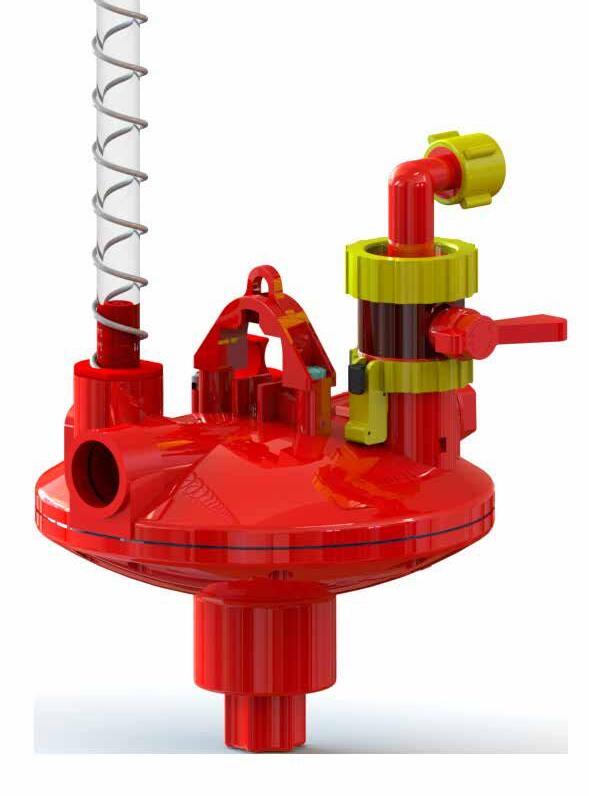


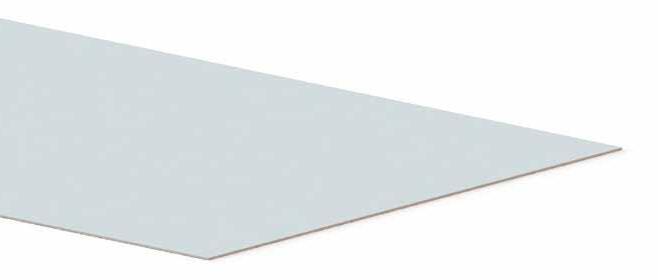




Use a QR code scanner on your device to access our website.





Corti Zootecnici manufactures conveyor belts for the collection and drying of manure in plain and perforated copolymer polypropylene
BELTS FOR COLLECTING AND DRYING MANURE EGG COLLECTION AND CONVEYOR BELTS
Corti Zootecnici manufactures conveyor belts for egg collection in woven and perforated polypropylene.
MADE IN ITALY www.cortizootecnici.it
corti_ zootecnici
Corti Zootecnici
Corti Zootecnici

Comprehensive study concludes chicken embryo pain perception starts on day 13th of incubation
The comprehensive study commissioned by the German Federal Ministry of Food and Agriculture has revealed that the perception of pain in chicken embryos begins on the 13th day of incubation. Countries such as France, Germany, and Italy are seeking alternatives through laws that prohibit the culling of male chicks.
The in-depth study focused on three phases, analyzing cardiovascular responses, electroencephalic neuronal activity, and embryonic movements. The results showed that significant brain activity begins on the 13th day,
marking the potential onset of pain perception, differing from previous studies. This finding is crucial for guiding future changes in the poultry industry and laws related to the culling of male chicks.
18 DOSSIER - dossier -
DOSSIER
In response to these findings, Germany has modified the ban on interrupting incubation, initially set at the seventh day, extending it to the 13th day. The article also explores emerging technologies to determine the gender of embryos without culling them. The research could influence future European Union regulations regarding the ban on culling male chicks, providing a clear understanding of the critical period when pain perception can begin, namely on the 13th day of development.
Every year in the EU, nearly 330 million one-day-old male chicks are killed in hatcheries. While females are raised for egg production, males are considered undesirable in both the egg and meat sectors due to their slow growth and limited meat yield at slaughter age. In response to this unethical practice, France, Germany, and Italy have taken the initiative to reinvent the poultry industry by enacting laws banning the culling of male chicks. This article delves into the research methodology and its implications, shedding light on the crucial intersection between ethical considerations and technological progress in the poultry industry.
Revolutionary insights into the sensation of pain in chicken embryos
With the prohibition of chick culling, French, German, and Italian hatcheries are shifting their focus toward advanced technologies capable of determining the sex of embryos within eggs, facilitating the identification and removal of eggs containing male chicken embryos. These excluded eggs find purpose in animal feed or scientific research. However, the animal welfare consciousness execution of this process hinges on a crucial question: what is the specific timeframe during which a chicken embryo in an egg is devoid of pain sensation? In previous research done in 2020 by the Bundestag’s scientific service, it was widely agreed that a chicken embryo lacks the capacity to feel pain before the seventh day but can certainly experience it after the 15th day.
In light of these insights, Germany planned to implement, from 2024, an extended regulation safeguarding chicken embryos in eggs from the seventh day of incubation. Within this timeframe, eggs could only be terminated, and embryos destroyed in the initial days. To gain deeper insights into the pain perception of chicken embryos, the German Federal Ministry of Food and Agriculture (BMEL)
commissioned a pivotal study. The groundbreaking outcome affirmed that chicken embryos remain insensitive to pain until incubation day 12.
Following a comprehensive approach, the research was divided into three parts.
The first phase of the study commissioned by the BMEL focused on cardiovascular responses to a mechanical noxious stimulus and uncovered intriguing insights into the maturation of chicken embryos’ cardiovascular systems. From day 7 to 18, a progressive increase in systolic, diastolic, and mean arterial pressure indicated a developmental trajectory. Nociceptive responses to a pinch stimulus on days 16, 17, and 18 revealed clear increases in mean arterial pressure, with varying heart rate responses. The application of local anesthesia with lidocaine successfully mitigated the increase in mean arterial pressure, underscoring the potential nociceptive nature of observed cardiovascular changes. While mean arterial pressure emerged as a reliable indicator of nociception, the variability in heart rate responses highlighted the need for a comprehensive evaluation.
Moving on to the second phase, which explored the embryonal development of electroencephalic neuronal activity, the study delved into the realm of brain activity in chicken embryos. The findings showcased consistent meaningful EEG activity commencing reliably from day 13, aligning with critical milestones in brain development observed in newly hatched chickens. The study’s exploration of the EEG’s capacity to reflect sensory input unveiled diverse electrical patterns in response to thermal and electrical stimulation. Importantly, evidence of conscious pain perception was absent before day 13, a conclusion supported by histological examination indicating potential nociception. The pivotal result suggests that meaningful EEG activity at developmental day 13 marks the initiation of potential nociceptive processing, providing a foundational understanding for subsequent in-depth investigations.
In the third and final phase, the study analyzed movements before and after a noxious stimulus, employing advanced technologies such as DeepLabCut alongside manual observations. The results uncovered a noteworthy increase in beak movements between days 15 and 18 following a noxious pinch stimulus, indicating a potential nocifensive reaction to perceived discomfort. Specific beak movements, including opening and wide
19 - april 2024 -
“The nuanced understanding of pain perception in chicken embryos, as highlighted by the comprehensive research on cardiovascular responses, electroencephalic neuronal activity, and embryonic movements, marks a transformative moment in poultry farming practices”
for the poultry industry as it navigates the delicate balance between ethical considerations and technological progress. Additionally, we explore the latest technologies employed for in-ovo sex determination.
Methods in chick sex determination
In response to ethical concerns surrounding the culling of male chicks, in ovo sexing methods have emerged. The methodologies detect the sex of the embryo inside of the egg and have branched into two, sample-extracting and contactless ones. The firsts involve fluid-based analysis (e.g. urinary fluid or blood), determining the sex of chicken embryos through embryonic DNA laboratory tests. While these methods have high accuracy and work for all breeds, a shell perforation is needed, which has an impact on hatchability and poses a contamination risk.
beak opening, occurred more frequently after the stimulus, hinting at signs of nociception. Additionally, head movements around the medial eye corner significantly increased on specific days, suggesting broader responses. The conclusion drawn from this phase emphasized that movement changes from day 15 to 18 after the stimulus likely signify a nocifensive response, providing a comprehensive understanding of nociception and pain perception development in chicken embryos during this critical developmental stage.
Recent study impacts german law, poised to transform EU legislation
Responding to these revelations, the BMEL decided to refine the prohibition on interrupting the incubation of male chicken embryos. The initial ban, set for the seventh day through sex determination in the hatching egg, has been adjusted to take effect from the 13th day of incubation. In the subsequent sections, we delve into the consequential findings of this study, which holds paramount importance
The contactless methods rely on physical traits to determine the embryo’s sex. Thus, they do not disturb the embryo development and do not affect its hatchability. One method uses hyperspectral measurement to see the feather color of the embryos but is limited to the brown-layer chicken breed. The second contactless method uses a combination of AI and Magnetic Resonance Imaging (MRI) for in ovo sex determination. MRI scans work on both brown and white eggs no matter their breed or size, offering a contactless and non-invasive method without a hatchability effect.
Conclusion
The nuanced understanding of pain perception in chicken embryos, as highlighted by the comprehensive research on cardiovascular responses, electroencephalic neuronal activity, and embryonic movements, marks a transformative moment in poultry farming practices.
The study’s outcomes, notably the identification of the developmental stage at which potential nociception occurs, might carry profound implications for the impending EU-wide regulation on the ban of male chicken culling. By delineating a clear time frame for the interruption of incubation of male chicken embryos – specifically, recognizing that pain perception becomes a possibility from day 13 onwards – the research aligns with the industry’s quest for ethical and humane practices.
20 DOSSIER - dossier -
MIXTA THE FEED PAN FOR TURKEYS, DUCKS AND MIXED CYCLES

No chick inside the pan.
Automatic feed level setting with the window opening system.
ONE SECOND immediate opening and closing of the bottom pan for complete and fast washing. FULLY AUTOMATIC




Leader in livestock feeding systems


DUO THE SUITABLE COMBINED FEEDING AND DRINKING SYSTEM


Only one winching system for two lines with more space in the shed.
Designed from one-day old to slaughtering age.
Automatic feed level setting with the window opening system.

QUALITY MADE IN ITALY www.azainternational.it I WANT AZA!
AUTOMATIC ADJUSTMENT
CLACK ONE SECOND TO CLOSE CLICK ONE SECOND TO OPEN EASY CLEANING Flexible rubber shock-proof cone
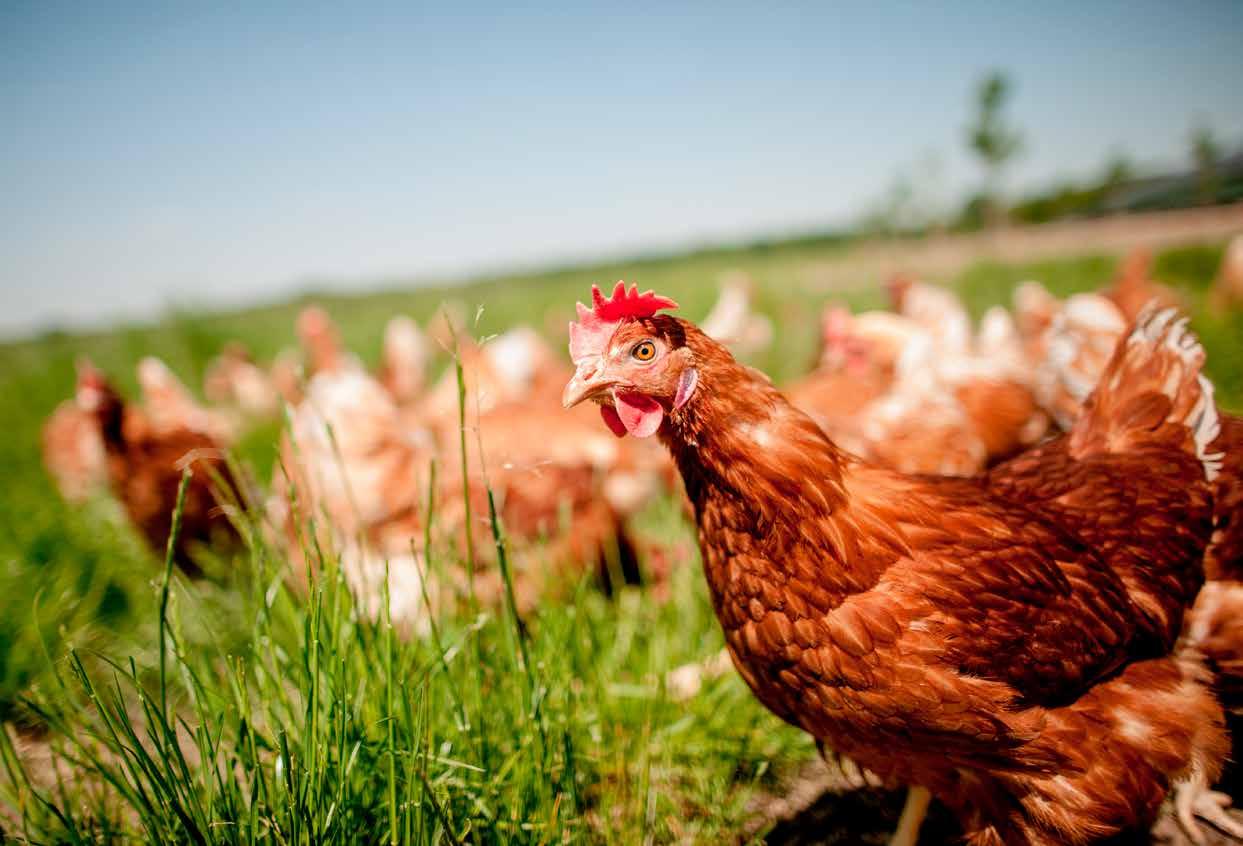
Organic acids as feed additives: pros and cons
Organic acid salts are often included as feed additives in livestock nutrition as feed preservatives but also as growth promoters, intestinal microbiota enhancers, and feed intake regulator. Yet, these beneficial effects on poultry performance and health are dose dependent and can lead to detrimental effects at elevated concentrations.
What are the benefits of adding organic acids into feed?
Aitor Arrazola, Research biologist, Ph.D. in Animal Behaviour & Welfare
Due to their chemical properties, dietary organic acids act as growth promoters and feed preservatives in poultry diets. Indeed, organic acids can suppress bacteria development at varying concentrations depending on the acid of interest and its chemical properties (stronger acids required lower concentration to achieve the same effect). For example, the minimal concentrations to inhibit bacteria growth ranges from 0.1% formic acid to 0.4% lactic acid for Sal-
22 FOCUS - focus -
monella typhimurium, Escherichia coli, Campylobacter jejuni, Staphylococcus aureus, and Clostridium spp. Certainly, organic acids have shown great efficacy against these economically relevant bacteria and fungi responsible for feed spoilage and food-borne diseases. Their antimicrobial efficiency relies on their capacity to enter inside the bacteria cell wall and lower their pH leading to cellular death. Depending on their pH sensitivity, some bacteria species are more resistant to organic acid exposure and may require greater concentration or stronger acids (e.g., lactic or formic acids compared to propionic acid) to kill them. As acids are corrosive in their liquid form, dietary organic acids are often added into feed as salts (e.g., calcium propionate, calcium lactate, calcium butyrate) to prevent acidosis and also for easy, safe management.
Beside lowering the risk of pathogen infection, proper inclusion rate of organic acids can support body weight gain and enhance feed conversion ratio. For example, inclusion rate around 0.25-0.50% of calcium propionate in poultry diets have been shown to have antimicrobial properties but also improve feed efficiency. In poultry diets, organic acids are associated with higher digestibility as well as greater nutrient absorption and utilization at different levels. Salts of organic acids can buffer the intestinal pH during digestion resulting in improving protein digestibility. Also, the stimulatory effect of organic acid salt on the morphology of the small intestine has been described in previous studies. Data from these studies highlight that, at optimal concentrations like above-mentioned, organic acids can promote integrity of the small intestines instead of resulting in gastrointestinal damage. Upon digestion, organic acids can further advance nutrient utilization as intermediates of metabolic pathways. Overall, and regardless of the mode of action, field research reinforces that enhanced digestibility and improved nutrient absorption and utilization translate into faster growth rate and/or heavy carcass weight when organic acid salts are used warily as feed additives. Similarly, feed efficiency also increased in poultry diets when organic acid salts are added jointly other feed additives such as dietary fibre. These effects altogether support the positive effect of organic acid salts from optimal poultry performance and health to food safety mediating multiple steps along the way in both broiler and layer chickens.
What about the side effects of dietary organic acids?
Early signs of negative side effects due to organic acids are subtle and depend on poultry age, previous experience with organic acids, and organic acid of choice. Regardless of metabolic acidosis, rising intake of organic acids can result in lower feed intake, hyperactivity and restlessness, and onset of health issues and other welfare problems (particularly in naïve chickens). Exposure and inclusion of organic acids should therefore be gradual in grower diets so chicks can adjust to small concentrations until reaching a beneficial concentration for growth promotion, pathogen bacteria control, and feed preservative. Although chickens can build up tolerance to organic acids, concentrations above 1% can reduce palatability of poultry diets and induce a negative sensation after feeding. Altogether, broilers fed with diets at an inclusion rate of 1-3% organic acid salt, and beyond, show a linear decrease in feed intake. Research suggests that chickens fed grower diets with organic acids at a higher concentration than before ate less feed and showed avoidance for that diet. Consequently, despite potential benefits in digestibility and nutrient utilization, poultry performance is compromised when inclusion rate exceeds 1.5% due to low daily feed intake.
Gauging what chickens experience when fed diets with 5% organic acid inclusion is not straightforward, but behavioural response of chickens suggest discomfort and ongoing stress under these conditions. In addition to these welfare concerns, greater concentrations of organic acids as feed additive induce health problems in the gastrointestinal tract. For example, results from research using experimental diets at 6-9% calcium propionate, fed unrestricted, indicated that birds started to develop lesions in their crops and stomachs. Low levels of organic acid salt appear to have a minimal effect on intestinal pH, but higher levels can underlie acidosis. Therefore, including organic acid salts as feed additives in grower and adult diets are advantageous to prompt body weight gain and lower count of pathogen bacteria and fungi in feed, but its inclusion rate should be carefully examined to prevent voluntary feed intake drop and other possible welfare or health problems.
- april 2024 - 23
FOCUS

Amino acid imbalances
1 Poultry Research Foundation within The University of Sydney. Camden NSW 2570
This paper considers amino acid imbalances in the context of reduced-crude protein diets, especially wheat-based diets. The likely genesis is differences in intestinal uptake rates of non- bound versus protein-bound amino acids results in their asynchronous parenteral appearances. Amino acid imbalances are more likely to occur in wheat-based diets because wheat typically has higher protein contents than other feed grains, which demands higher inclusions of non- bound amino acids.
24 MANAGEMENT - management -
P.H. Selle1, S.P. Macelline1, P.V. Chrystal1 and S.Y. Liu1
Introduction
The term ‘amino acid imbalances’ was probably originated by Elvehjem and Krehl (1955) and the topic was addressed by Harper and Rogers (1965). Their conclusion was that imbalances retard growth by altering the normal pathways of amino acid metabolism. Thus, while the relevance of amino acid imbalances to efficient chicken-meat production is recognised, a precise definition has yet to be developed. Antagonisms between arginine and lysine and the branched-chain amino acids, isoleucine, leucine and valine have been reported to depress feed intake in poultry and could be seen as amino acid imbalances. However, this paper considers amino acid imbalances generated by inclusions of non-bound (synthetic, crystalline) amino acids (NBAA) as opposed to protein-bound amino acids in diets for broiler chickens. These imbalances are increasingly declared in birds offered reduced-crude protein (CP) diets because of high NBAA inclusions to meet specifications. The lack of bioequivalence between non-bound versus protein-bound amino acids is fundamental to the genesis of amino acid imbalances in this context.
Initially, synthetic d,l-methionine was made available for animals in 1953; however, intestinal uptakes of synthetic or non-bound methionine were subsequently shown to be more rapid than protein-bound methionine by Canolty and Nasset (1975). Cumulative plasma methionine concentrations in rats offered synthetic methionine at 15, 30, 60 and 120 minutes post-administration were 2.75 time higher (858 versus 312 µmol/L) than in rats receiving methionine only from intact protein. Moreover, that nonbound lysine and methionine are absorbed more rapidly than their protein-bound counterparts in broiler chickens was reported by Liu et al. (2013). It may be deduced from this study that the average digestion rate constants of non-bound lysine and methionine were approximately 3.7 times higher (8.64 versus 2.35 10 -2 min-1) than protein-bound amino acids.
Amino acid imbalances in broilers offered reduced-CP diets
Instructively, Baker (2009) suggested that there are limits to the extent that intact protein can be replaced by NBAA in terms of achieving maximal weight gain and feed efficiency. This was illustrated by Macelline et al. (2022) in
an equilateral triangle response surface design with diets formulated to 203 g/kg true protein but the three apical diets contained 6.75, 19.4 and 66.9 g/kg NBAA. The diet containing 13.1 g/kg NBAA supported maximum weight gain and minimum FCR observed and higher NBAA inclusions penalised growth performance.
Broiler chickens are intermittent, rather than continuous feeders and the likelihood is that this contributes to post-enteral imbalances between non-bound and protein-bound amino acids at sites of protein synthesis, stemming from differences in amino acid intestinal uptake rates. Amino acids may be captured by catabolic pathways as they transit enterocytes of the small intestinal mucosa and are denied entry into the portal circulation. However, the possibility is that non-bound amino acids are less likely to be catabolised given their proximal sites of absorption where starch/glucose is readily available as an alternative energy substrate, which is supported by data in Moss et al. (2018). If so, this would exacerbate differences in amino acid intestinal uptake rates. Nevertheless, dietary amino acids that exceed requirements for protein synthesis are rapidly catabolized, which had been defined as post-prandial amino acid oxidation. Subsequently, Nolles et al. (2009) compared postprandial oxidation of egg white protein as the sole amino acid source with a corresponding blend of non-bound amino acids via [13CO 2] breath tests in rats. Postprandial oxidative losses of non-bound leucine were significantly higher than protein-bound leucine by approximate factors of 1.52 (24.8 versus 16.3%) after a short adaptation period. It appears that NBAA are more likely to be lost to post- prandial oxidation because of their more rapid intestinal uptakes.
The moderation of amino acid catabolism would decrease amino acid requirements; potentially, this holds importance and would be partially achieved if amino acid imbalances were to be diminished. Moreover, amino acid catabolism attracts metabolic costs in terms of both protein and energy. The catabolism of amino acids axiomatically generates a protein cost; however, the resultant synthesis and excretion of uric acid to void N in urine generates a minimal energy cost of 64.7 kJ/g N excreted as uric acid. Uric acid concentrations in broiler excreta were determined in Selle et al. (2021) and the proportion of dietary energy intakes partitioned to uric acid synthesis and excretion was up to 2.26% of gross energy (17.21 MJ/kg GE) or 2.98% of metabolisable energy (13.06 MJ/ kg AME) over the total excreta collection period to de -
25
- april 2024MANAGEMENT
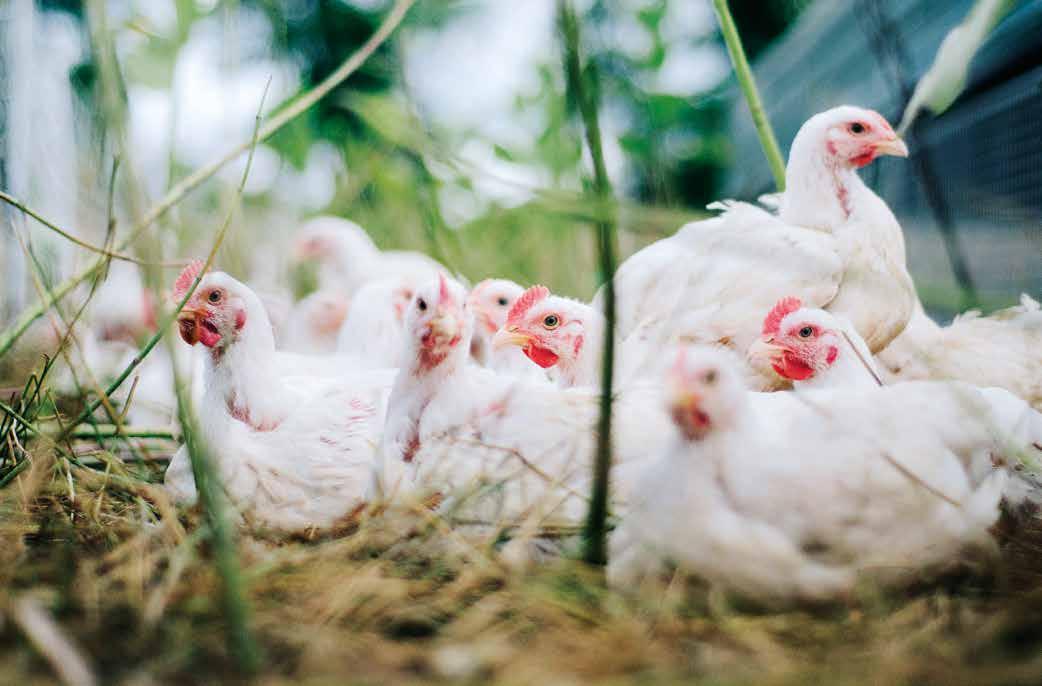
termine AME. Excreta uric acid concentrations were also determined in Brink et al. (2022) in a study involving wheat-based, grower and finisher diets with three CP levels. Mean excreta uric acid concentration was 66.4 mg/g (range: 47.9 to 80.5 mg/g), which represented 47.1% (range: 40.0 to 53.1%) of total N excreted. Thus, 47.1% of total N in excreta was derived from uric acid in urine and the balance of 52.9% was derived from undigested and microbial N in faeces. Interestingly, Brink et al. (2022) suggested that N derived from uric acid in litter is more readily volatilised into atmospheric NH3 than other N forms in excreta.
There are indications that NH3 is more toxic in poultry than mammalian species. Under normal conditions, broiler chickens detoxify NH3 via a reaction catalysed by glutamine synthetase in which NH3 and glutamic acid are condensed into glutamine. Glutamine then enters the Krebs uric acid cycle which generates uric acid, which is voided in urine. However, if NH3 detoxification is inadequate, plasma NH3 concentrations will be elevated and this has been associated with depressed growth perfor-
mance in three broiler studies. Adequate NH3 detoxification could be challenged by excessive amino acid catabolism triggered by high dietary NBAA inclusions. Also, as glycine is a prerequisite for the Krebs uric acid cycle, it follows that any deficiency of glycine (and serine) would result in inadequate NH3 detoxification. Selle et al. (2021) estimated that between 25.0% and 80.9% of dietary glycine entered the Krebs cycle for uric acid synthesis in the Chrystal et al. (2021) study, which does not account for endogenous glycine synthesis.
The concept of inadequate NH3 detoxification or ‘ammonia overload’ is supported by the outcomes reported in Greenhalgh et al. (2022). The inclusion of 75 mg/kg L-carnitine in 160 g/kg CP, sorghum-based diets, containing 51.02 g/kg NBAA, improved weight gain by 15.0% (1580 versus 1374 g/bird) and FCR by 8.82% (1.521 versus 1.615) from 7 to 33 days post-hatch. However, it is recognised that L-carnitine is protective against NH3 toxicity. This raises the distinct possibility that the L-carnitine responses observed stemmed from its capacity to counteract the negative effects of ammonia overload. This is
26 MANAGEMENT - management -
because L-carnitine inclusions in 220 and 190 g/kg CP diets, containing 15.19 and 29.26 g/kg NBAA, respectively, failed to generate growth performance responses. Also increasing NBAA inclusions were found to linearly (r = 0.546, P = 0.019) related to plasma NH3 concentrations in an unpublished study. Both outcomes support the contention that high NBAA inclusions in reduced-CP diets could trigger ‘ammonia overload’.
Wheat-based, reduced-CP diets
Wheat is the dominant feed grain in Australian chicken-meat production. However, the capacity of broilers to accommodate CP reductions in wheat-based diets is highly variable as evidenced by several local studies. For example, 30 g/kg CP reductions in grower and finisher diets numerically depressed FCR by 2.19% (1.542 versus 1.509) from 10 to 35 days post-hatch in Hilliar et al. (2020). Alternatively, similar CP reductions significantly compromised FCR by 7.24% (1.452 versus 1.354) in broilers in Hilliar et al. (2019) and by 9.38% (1.609 versus 1.471) from 7 to 35 days post-hatch in Dao et al. (2021). In Yin et al. (2020), CP reductions from 215 to 190 g/kg CP depressed FCR by 1.42% (1.497 versus 1.476) and from 215 to 165 g/kg by 4.74% (1.497 versus 1.476) from 14 to 35 days post-hatch. In contrast, CP reductions from 197.5 to 180 g/kg CP compromised FCR by 11.5% (1.878 versus 1.684) and from 197.5 to 162.5 g/kg CP by 44.1% (2.426 versus 1.684) from 14 to 35 days post-hatch in Greenhalgh et al. (2020). Also, the CP reduction from 222 to 165 g/kg CP compromised FCR by 26.6% (1.840 versus 1.453) in Chrystal et al. (2021).
Maize was superior to wheat as the basis of reduced-CP diets in Chrystal et al. (2021). Moreover, there is a quadratic relationship (r = 0.962; P = 0.0004) between NBAA inclusions, which ranged from 7.23 to 49.39 g/kg, with mean FCR observed in birds offered nine dietary treatments. It may be deduced from the quadratic equation that the minimum FCR of 1.403 from 7 to 35 days posthatch was realised with NBAA inclusions of 17.49 g/kg and FCR deteriorated in a quadratic manner when this inclusion level was exceeded. In a European study, 30.0 g/kg CP reductions in wheat-based grower and finisher diets numerically depressed FCR by 2.03% (1.50 versus 1.48) from 1 to 39 days post-hatch when fed as pellets. This promising outcome was probably facilitated by the relatively low average NBAA inclusions of 16.6 g/kg in the
reduced-CP grower and finished diets. Curiously, when fed as mash, a significant improvement in FCR of 5.33% (1.60 versus 1.69) was observed. Presumably, mash diets had higher protein solubility and digestibility and it is probable that birds offered mash diets consumed feed more frequently. Both factors may have reduced the magnitude of post-enteral amino acid imbalances to the benefit of FCR in birds offered reduced-CP, mash diets. Finally, the likelihood is that wheat-based, reduced-CP diets will be advantaged by limited NBAA inclusions, which can be facilitated by incorporating feedstuffs with lower protein contents than soybean meal into their formulations. This strategy should constrain the deleterious impacts of amino acid imbalances in birds offered reduced- CP, wheatbased diets, but the likelihood that there are additional inherent factors in wheat that will need to be addressed including soluble NSP, rapid starch digestion rates and possibly amylase-trypsin inhibitors and gluten.
References are available on request
From the Proceedings of the Australian Poultry Science Symposium 2023

• customised advice and inhouse production
• high-quality raw materials and strict quality standards
• chicken house equipment from planning to support www.specht-germany.com
27
- april 2024MANAGEMENT
M. Rice1, R. Galea1, A. Fisher1, P. Taylor1,2 and P. Hemsworth1
1 Animal Welfare Science Centre, Faculty of Science, The University of Melbourne, Parkville 3010, Australia
2 School of Agriculture, Food and Ecosystem Sciences, Faculty of Science, The University of Melbourne, Parkville 3010, Australia

Does smothering occur in rearing?
Recent research indicates that smothering accounts for up to 16% of mortality in adult laying hens in Australian commercial free range egg farms. In addition, UK data indicates that piling (a precursor to smothering where hens press tightly together into dense packs) has implications not only for the risk of mortality due to smothering, but also may negatively impact egg production.
Smothering research to date has been focused on identifying risk factors in adult flocks, but there is little available information on the incidence of, and possible risk factors for, smothering during rearing. This study aimed to investigate the incidence of smothering during rearing utilizing a limited data set collected within the research conducted by Hemsworth et al., (2022).
Surveys on management practices and flock behaviour were completed by rearing managers in relation to 50 pullet flocks across Victoria (n=21) and Queensland (n=29). The flocks were ei-
28 MANAGEMENT - management -
ther Hy-line Brown (n=42), ISA Brown (n=7) or mixed (ISA Brown and Lohmann, n=1) and were housed indoors in either aviary (n= 17), jumpstart (n= 26) or floor rearing (n = 7) systems from day-old chicks. The surveys were completed by flock managers when the flocks were 16-17 weeks old.
Smothering-related mortality was reported in 44% of the flocks in the study, occurring between 3 to 15 weeks of age. Smothering occurred in 71% (n = 12) of aviary flocks, 35% (n = 8) of jumpstart flocks and 14% (n = 1) of floorreared flocks. Reported locations for smothering were next to gates or partitions (36%, n = 4), at either the front or the back of the shed (27%, n =3), against walls (9%, n =1), in the system (18%, n =2), or near cooling pads or exhaust fans (9%, n =1). Preliminary analyses on some management practices were conducted using t-tests comparing the mean set temperature (temperature setting for the climate control) and lux (at the time of the survey) of flocks that smothered compared to those that did not. There was no significant difference in shed temperature between flocks with smothering compared to flocks with no smothering. However, in flocks where smothering
IT’S WHAT YOU DON’T SEE THAT SETS US APART
Sustainability
Boots are an essential item of footwear worn by growers of sustainable feed crops for our world-class turkeys. We are committed to improving the environmental footprint of turkey production through genetic improvement of our breeds. If you choose Aviagen® Turkeys you will balance your need for profits with our responsibility to protect the planet.
For more information about our entire range, visit www.aviagenturkeys.com
The ethical choice for a world that deserves to be protected
occurred, the lux at the time of the survey was significantly lower (xˉ Smother = 14.1 ± 2.1 lux, xˉ No smother = 41.3 ± 4.2 lux, p < 0.001). Manipulation of lux is a common management practice to reduce problem behaviours, and thus this association may simply reflect a management strategy to reduce smothering in problematic flocks.
These results are based on a limited data set and thus it is not possible to determine causal factors or risk factors; however, it does clearly indicate that smothering and piling occur during rearing as early as 3 weeks of age. Since early life experiences are known to influence the behaviour of the adult laying hen, there is a need to conduct further research into piling and smothering behaviours during rearing as these behaviours, which are known to be problematic in adult flocks, may actually develop during rearing.
References are available on request
From the Proceedings of the Australian Poultry Science Symposium 2024

29 - april 2024MANAGEMENT

Influence of dietary CP, dietary SID Lys and amino acid production origin on performance and global warming potential of broilers
W. Lambert1, T. Chalvon-Demersay1, J. Le Cour Grandmaison1, S. Fontaine1 and R. Bouvet 2
1 METEX NOOVISTAGO, 32 rue Guersant 75017, Paris, France
2 Zootests, 5 rue Gabriel Calloet Kerbrat, 22440 Ploufragan, France
This study indicates that dietary CP can be drastically reduced in different nutritional contexts without negatively affecting growth performance, and with positive benefits on the environment.
Introduction
The nutritional strategy of reducing dietary crude protein (CP) in broiler diets to improve the sustainability of poultry production has been widely reviewed in the recent years. This strategy has proven benefits on global warming potential (GWP) and litter quality. In terms of growth performance, there is still a controversy on the ability of reduced-protein diets to
30 NUTRITION - nutrition -
NUTRITION
maintain similar performance levels. To our knowledge, there has been no study so far on the influence of reducing dietary CP in broilers on GWP with two levels of dietary SID Lys and different origins of AA production. The objective of the present experiment was therefore to investigate the influence of dietary CP, AA density (SID Lys) and their interaction on global warming potential with two scenarios of AA origin.
Method
The six experimental treatments consisted in a 3 x 2 factorial design with 3 levels of dietary CP (High, Medium = -1%pt CP, Low = -2%pts CP) x 2 levels of dietary SID Lys (High, Low) with 0-35d male Ross 308 broilers (the grower diet composition is given as an example in Table 1). The reduction of dietary CP was applied by partially replacing SBM by cereals and feed-grade AA. The low SID Lys levels were formulated to match 90% of the Aviagen recommendations. Average daily gain, average dai-
ly feed intake and feed conversion ratio were monitored. Global warming potential was calculated kg of live weight broiler (GWPkg, kgCO2eq/kg of live weight (LW) broiler). GWP of the feeds was based on GFLI (Blonk consultants, 2019), except for the micro-ingredients (EcoAlim) and AA METEX NOOVISTAGO database, following FAO (2020) guidelines; available in Agribalyse (2022) V3.1). As GWP values of AA differ a lot between the countries of production, it was chosen to implement 2 scenarios: 1) AA are produced in Europe Union (EU) or 2) AA are produced in China (CN). The main difference between the two countries of production come from the raw material mix to produce feed-grade L-AA: EU = sugar beet, CN = glucose from corn. All data were submitted to a 2-way ANOVA statistical analysis. In addition, a 3-way ANOVA was performed for GWP with dietary SID Lys, dietary CP and AA sourcing strategy as main effects and their interactions. Significance was considered at P<0.05. Statistical analysis was conducted using Minitab, version 21.
31 - april 2024 -
SID Lys Low High Crude protein High Med Low High Med Low Ingredient composition, % Corn 43.60 46.80 50.10 37.20 41.10 44.70 Soybean meal, 48% 27.20 24.00 20.70 32.90 29.20 25.60 Wheat 20.00 20.00 20.00 20.00 20.00 20.00 Soya oil 4.50 4.40 3.90 5.90 5.20 4.60 Monocalcium phosphate 1.30 1.30 1.30 1.30 1.30 1.30 Calcium bicarbonate 1.10 1.10 1.10 1.10 1.10 1.10 Sodium bicarbonate 0.17 0.35 0.52 0.13 0.13 0.33 Salt 0.30 0.30 0.30 0.30 0.30 0.30 DL-Met 99% 0.25 0.28 0.31 0.29 0.32 0.35 L-Lys HCl 99% 0.25 0.35 0.45 0.22 0.33 0.44 L-Thr 98.5% 0.19 0.23 0.27 0.20 0.25 0.30 L-Val 98% 0.07 0.13 0.18 0.07 0.13 0.19 L-Arg 98% 0.03 0.13 0.22 0.10 0.20 L-Trp 98% 0.01 0.01 L-Ile 93.4% 0.01 0.06 0.12 0.05 0.12 Premix 0.50 0.50 0.50 0.50 0.50 0.50 Formulated nutrient composition, % Crude protein 18.90 18.00 17.10 21.00 20.00 19.00 SID Lys 1.04 1.04 1.04 1.15 1.15 1.15 SID Lys/CP 5.50 5.78 6.08 5.48 5.75 6.05 AMEn broiler (kcal/kg) 3,100 3,100 3,100 3,100 3,100 3,100
Table 1 – Ingredient and nutrient composition of the six experimental grower diets fed from 10 to 21d (grower feed) to broiler chickens.
Results
Broilers outperformed the Aviagen (2018) performance objectives for Ross 308 male broilers by 385g of BW and by -11pts for FCR. No interaction between SID Lys and dietary
CP was observed for any of the performance parameters (P>0.05). Increasing dietary SID Lys significantly increased BW, ADG and reduced FCR from 0 to 14d, 14 to 21d, 21 to 35d and 0 to 35d (P<0.05; Table 2). On the other hand, reducing dietary
CP did not impact performance (P>0.05) except for FCR before 21d. The reduction of dietary CP reduced GWPkg with both AA origin but the extent of reduction was much greater with EU AA as compared to CN AA (Figure 1). For instance, reducing
a-c Values in a column with no common superscripts differ significantly (P<0.05) – Tukey test.

dietary CP from High to Low dietary CP reduced GWPkg by 2.9% when using CN AA, and reduced GWPkg by 12% when using EU AA. In addition, switching the AA origin from CN to EU production reduced GWPkg by 2.4% in the High dietary CP treatments and reduced it by 10% in the Low dietary CP treatments.
Discussion
The novelty of the study was to test dietary CP and SID Lys nutritional stra te gies in a factorial design. In
32
- nutrition -
Figure 1 – Global warming potential of broilers in g CO2eq per kg of live weight broiler fed diets differing in dietary CP and AA sourcing strategy from 0 to 35d of age.
NUTRITION
Treatments1 Body weight g/bird Feed conversion ratio g/g SID Lys CP Day 14 Day 21 Day 35 Day 14-21 Day 21-35 Day 0-35 Low High 563 1,141 2,530 1.294 1.591 1.385 Low Med 557 1,128 2,520 1.299 1.592 1.391 Low Low 570 1,142 2,520 1.330 1.599 1.397 High High 570 1,195 2,705 1.190 1.506 1.313 High Med 579 1,203 2,763 1.204 1.494 1.316 High Low 576 1,193 2,687 1.221 1.520 1.332 SEM 2.7 6.7 17.4 0.007 0.007 0.005 Main effects SID Lys Low 564b 1,137b 2,523b 1.308a 1.594a 1.391a High 575a 1,197a 2,718a 1.205b 1.507b 1.320b CP High 567 1,168 2,617 1.242b 1.549 1.349 Med 568 1,166 2,641 1.252ab 1.543 1.354 Low 573 1,168 2,604 1.276a 1.560 1.364 P-value SID Lys x CP 0.370 0.651 0.383 0.598 0.661 0.734 SID Lys 0.035 < 0.001 < 0.001 < 0.001 < 0.001 < 0.001 CP 0.615 0.987 0.433 < 0.001 0.329 0.056
Table 2 – Growth performance of broilers fed experimental diets differing in dietary CP and dietary SID lysine (10 replicates of 17 broilers per pen).

this study, intermediate levels of SID Lys/CP were tested compared to recent publications. There was no interaction between the two strategies, meaning that the reduction of dietary CP is achievable whatever if broilers are fed a low or a high level of AA density. Therefore, based on this experiment, the achievable level of dietary CP in practice could be as low as 17% in grower and 15.3% in finisher diets when formulating with dietary SID Lys at 90% of Aviagen (2018) recommendations. The effect of reducing dietary CP on GWP of broiler has already been evaluated by Mosnier et al. (2011), Kebreab et al. (2016) and reviewed by Cappelaere et al. (2021). For example, Mosnier et al. (2011) evaluate d that the reduction of dietary CP reduced GWP by 5.3% compared to control, but this result was dependent on regions of production of SBM and corn.
The novelty of the present study is that 1) the latest published GWP databases were used to study the impacts of the nutritional interventions, 2) 2 scenarios of AA sourcing strategy were compared, and 3) basic nutritional strategies such as increased SID Lys or reduced dietary CP were tested. However, regarding the methodology of the study, it was not possible to integrate the farm characteristics and the manure management strategy in this study like in Mosnier et al. (2011).

CARFED INTERNATIONAL LTD
Italian headquarters: Piazza Oberdan 3, 20129 Milano (Italy)
References are available on request From the Proceedings of the Australian Poultry Science Symposium 2023

Italian warehouse: Via Basilicata 10, 20098 San Giuliano Milanese (Italy) Ph.: +39 02 9881140 – Fax: +39 02 98280274 Email: carfed@carfed.it – Website: www.carfed.it
33 - april 2024NUTRITION
UK
Floor
Avenue London,
44. 20. 7660.0987
headquarters: 2nd
Gadd House, Arcadia
England, N3 2JU, UK Ph.: +
– Email: carfed@carfed.co.uk

Can a saponin-aluminosilicate blend
promote resilience to coccidiosis in broilers?
M. Brink1, B. Bruneel1, M. Sinclair1, F. Atienza1, J. Van Soest1, C. Fritzlen2 and M.E. Persia 2
1 Orffa Additives B.V., Breda, The Netherlands
2 School of Animal Sciences, Virginia Tech, United States
In broilers, coccidiosis leads to reduced growth and feed efficiency and it is often a predisposing factor to secondary diseases such as necrotic enteritis. Coccidiosis is commonly controlled with conventional control strategies such as prophylactic anticoccidial drugs and the use of vaccines. However, these strategies cannot fully prevent Eimeria infection and performance losses still occur due to subclinical coccidiosis. Natural solutions, such as saponins derived from the Quillaja saponaria Molina tree and aluminosilicates can bring added value to coccidiosis management strategies by reducing disease pressure and improving intestinal health.
34 NUTRITION - nutrition -
Introduction
Coccidiosis is one of the main disease challenges affecting broiler production worldwide. This disease has a significant economic impact on the poultry industry and the global cost of coccidiosis in chickens linked to prevention, treatment, and performance losses is estimated at US$13 billion or US$0.20 per bird. Coccidiosis is caused by protozoan parasites of the genus Eimeria. Seven different Eimeria species are known to affect chickens, each with a different pathogenicity and targeting a specific location in the intestinal tract. In order to replicate, these parasites invade the intestinal cells of the host, which results in tissue damage, impaired nutrient digestion and absorption, and compromised well-being and growth performance in broilers. Furthermore, coccidiosis is also a predisposing factor to secondary diseases such as necrotic enteritis induced by Clostridium perfringens
Current prevention and control of coccidiosis is mainly based on the use of anticoccidials and live vaccines. The extensive prophylactic use of anticoccidials has resulted in resistant Eimeria strains and loss of efficacy. Vaccines, on the other hand, have a high relative cost and, if managed incorrectly, can predispose the animals to subclinical coccidiosis and necrotic enteritis. In broilers, vaccines often do not lead to a timely build-up of immunity.
With these drawbacks, broiler producers are looking for new tools to add to their global coccidiosis management strategy. Natural feed additives, such as saponin-rich plant extracts, are among the promising approaches used to control coccidiosis in broilers. Saponins are found in many plant species and are known to be antimicrobial, to inhibit mould, and to protect plants from insect attack. As a result, saponin extracts from plants such as the Quillaja saponaria Molina tree have a wide range of applications in livestock production and can be used as antibacterial, antiviral, and antiparasitic agents, as well as adjuvants. The antiparasitic effect of saponins may be linked to their detergent action: the hydrophobic part of the saponin can integrate into the membrane of protozoa to form complexes with sterols, resulting in pore formation and cell lysis. Aluminosilicates are clay minerals which are also widely used as feed additives to improve growth performance and health of animals, mainly due to their ability to adsorb heavy metals, ammonia, mycotoxins and toxins, thereby protecting the integrity of the intestinal tract.
The objective of this study was to investigate the effect
of a blend of Quillaja saponaria extract (a source of triterpenoid saponins) and aluminosilicate on oocyst excretion, intestinal lesions and productive performance in broilers raised on used litter seeded with coccidia oocysts.
Methods
One-day-old male Ross 708 broilers were obtained from a commercial hatchery (Elizabethtown, PA, USA) and, after sorting for health, 1152 chicks were assigned to 48 floor pens (24 broilers per pen). The trial consisted of four treatments that were randomly assigned to the pens, each with 12 replicates: a positive control with no anticoccidials and reared on clean pine shaving litter (PC); a negative control with no anticoccidials added to the diet and reared on used pine shaving litter (NC); a negative control with 60 mg/kg of an anticoccidial (salinomycin: Bio-Cox ® 60g, Huvepharma Inc.) added to the diet and reared on used pine shaving litter (NC + sal); a negative control with a saponin-aluminosilicate blend (Excential Sapphire Q, Orffa Additives B.V.) providing 30 mg/kg of Quillaja saponaria extract in the diet and reared on used pine shaving litter (NC + sap-al).
The used litter containing Eimeria oocysts was generated as follows: In 48 separate floor pens, a total of 1200 oneday-old male Cobb chicks from a female broiler breeder line were housed (25 birds per pen) on clean pine shavings and received a 10x dose of a coccidiosis vaccine (Coccivac ® B52, Merck Animal Health) via the feed for the first two days. The vaccine consisted of the following strains: E. acervulina, E. maxima, E. maxima MFP, E. mivati, and E. tenella. The birds were reared until 18 days of age to allow for at least three cycles of coccidiosis oocyst shedding into the litter. The used litter was then collected, mixed, and redistributed into the experimental pens. The broilers had free access to feed and water during the whole experimental period and were fed in three phases that is, starter (0 to 16 days), grower (16 to 29 days) and finisher (29 to 42 days). The diets were maize and soybean meal-based and were fed in a crumble form during the starter period and pellet form during the grower and finisher periods.
Mortalities were recorded daily. At 0, 17, 28, and 42 days of age (at the end of each feeding phase), body weight (BW) and average daily feed intake (ADFI) were determined to calculate the body weight gain (BWG) and feed conversion ratio (FCRm) (after correcting for mortalities) for the
35 - april 2024NUTRITION
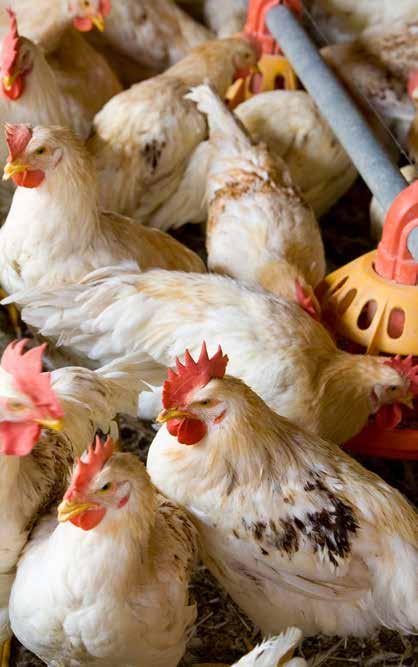
time periods 0 to 16, 0 to 29, and 0 to 42 days. At 16 days of age, three birds per pen were euthanised for macroscopic intestinal lesion evaluation using the methods described by Conway and McKenzie (2008)
and Johnson and Reid (1970). On days 11 to 13, 17 to 19, and 22 to 24, fresh excreta samples were collected and pooled from each pen to determine the number of oocysts shed per gram of excreta. Oocysts were stored and processed as outlined by Long et al. (1970) and counted using procedures described by Dalloul et al. (2003), with the modification of correcting for total grams of excreta collected.
Broiler performance, intestinal lesion scoring, and oocyst shedding were analysed as one- way ANOVA using JMP Pro 16 (SAS Institute Inc., Cary, NC) with the significance level set at 0.05. Blocking within the house was used as a random variable within the model. Results were expressed as least square means (lsmeans) and the standard error of those means (SEM). If global ANOVA was significant, significant differences between lsmeans were determined using Fishers least significant difference test.
Results
From 0 to 16 days, the NC + sal and NC + sap-al treatments had higher ADFI (P=0.004) and BWG (P=0.009) compared to NC and similar performance to PC (P>0.05) (Table 1).
From 0 to 29 days, there were no differences in ADFI (P=0.198) among the treatments, but BWG was higher for the PC, NC + sal, and NC + sapal treatments compared to the NC treatment group (P=0.018). For the overall period from 0 to 42 days, NC + sal had a higher BWG compared to NC, with the PC and NC + sapal treatments being intermediate but not significantly different from the NC and NC + sal treatments. For FCRm from 0 to 42 days the NC + sal and NC + sap-al treatments tended to improve the overall FCRm compared to the NC treatment (P=0.053).
No differences in lesion scores were noted among treatments in the duodenum (P=0.509), jejunum (P=0.101) and ileum (P=0.579) (Table 2).
0 to 16 days of age
0 to 29 days of age
0 to 42 days of age
a,b Values in a row with no common superscript differ significantly (P<0.05).
36 NUTRITION - nutrition -
Treatments PC NC NC + sal NC + sap-al SEM P-value BW at day 0 43.1 43.0 43.4 43.4 0.2 0.632
Table 1 - Effects of treatments on broiler body weight gain (BWG), average daily feed intake (ADFI) and mortality corrected feed conversion ratio (FCRm) from 0 to 16, 0 to 29, and 0 to 42 days of age.
ADFI (g/broiler) 40.5a 37.9b 40.3a 39.4a 0.5 0.004 BWG (g/broiler) 468a 432b 473a 458a 8.6 0.009 FCRm 1.32 1.35 1.31 1.32 0.01 0.127
ADFI (g/broiler) 72.3 69.2 71.1 70.2 1.0 0.198 BWG (g/broiler) 1491a 1407b 1499a 1469a 21.2 0.018 FCRm 1.47 1.48 1.44 1.44 0.02 0.225
ADFI (g/broiler) 104.7 101.8 107.7 103.6 2.0 0.215 BWG (g/broiler) 2999ab 2869b 3110a 2997ab 53.9 0.030 FCRm 1.57ab 1.60b 1.55a 1.56a 0.01 0.053
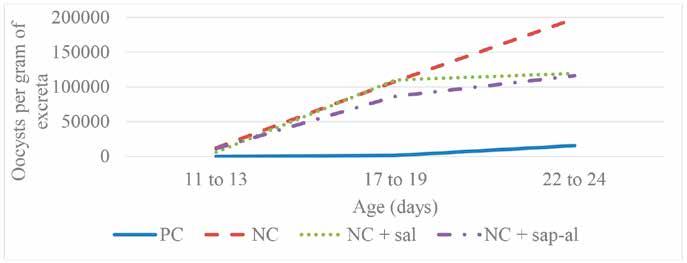
From 11 to 13 days, the lowest oocyst shedding was observed for PC and the highest shedding for NC and NC + sap-al treatments, with the NC + sal treatment being intermediate (P<0.001) (Figure 1). No significant differences in oocyst shedding were found between the treatments from 17 to 19 days (P=0.209), although the PC group showed numerically the lowest oocyst counts on these days. From 22 to 24 days, a trend was observed for oocyst counts (P=0.063).
The NC + sal and NC + sap-al treatments tended to reduce the number of excreted oocysts compared to the NC treatment. The PC treatment showed numerically the lowest oocyst excretion on these days.
Discussion
In the current study, the coccidia challenge was confirmed by lower oocyst counts for the PC and higher oocyst counts for the NC between 11 to 13 days. No significant differences in oocyst counts were observed be -
tween treatments for the collection periods 17 to 19 days and 22 to 24 days, possibly due to large variation within treatments. However, for the collection period between 22 to 24 days, oocyst excretion was reduced by 39.7% and 41.3% compared to negative control, when salinomycin or the saponin-aluminosilicate blend was fed, respectively, indicating a direct anticoccidial effect of these additives. Saponins are amphiphilic molecules and are natural detergents because they contain a fat-soluble nucleus or sapogenin and water-soluble carbohydrate side chains. The reduction in oocyst excretion seen for broilers fed the saponin-aluminosilicate blend was likely the result of the affinity for and ability of the sapogenin portion of the saponins to form complexes with cholesterol in the protozoal cell membrane. This would have affected the integrity of the parasite membrane by leading to pore formation and cell lysis and preventing the parasites from infecting intestinal cells and replicating. The saponin-aluminosilicate blend
was able to improve the growth of coccidiosis-challenged broilers to a similar level as the unchallenged control and broilers fed salinomycin, an anticoccidial drug. A coccidiosis challenge generally occurs concurrently with necrotic enteritis which is caused by toxins produced by Clostridium perfringens. One beneficial effect of aluminosilicates is their ability to bind enterotoxins in the intestinal tract of animals. In this study, the improved performance seen for the NC + sap-al treatment compared to the NC treatment group may also have been due to the aluminosilicate which adsorbed toxins produced by opportunistic pathogens in the coccidiosis- challenged broilers, reducing intestinal damage and thereby improving growth.
The results of the current study indicate that the saponin-aluminosilicate blend can promote the resilience in broilers to coccidiosis. This blend can be implemented to further reduce the negative effect of subclinical coccidiosis on growth and feed efficiency in broilers and reduce the costs associated with these performance losses. If the societal demand for antibiotic-free animal products keeps increasing, this natural blend can provide a viable alternative for anticoccidial treatment in broilers.
References are available on request From the Proceedings of the Australian Poultry Science Symposium 2024
37 - april 2024NUTRITION
Treatments PC NC NC + sal NC + sap-al SEM P-value Duodenum 1.42 1.09 1.15 1.28 0.16 0.509 Jejunum 1.20 1.03 0.91 0.78 0.12 0.101 Ileum 0.89 0.70 0.88 0.69 0.13 0.579
Table 2 – Effects of treatments on intestinal lesion scores in broilers at 16 days of age.
Figure 1 – Effects of treatments on oocyst counts in excreta of broilers during three collection periods.

Research shows vertical transmission of Salmonella Reading in breeders
USPOULTRY and the USPOULTRY Foundation announce the completion of a funded research project by researchers at Mississippi State University that shows the vertical transmission of Salmonella Reading in breeders. The research was made possible in part by an endowing Foundation gift from Cargill. The research is part of the Association’s comprehensive research program encompassing all phases of poultry and egg production and processing.
Project #729: Evaluating vertical transmission of Salmonella Reading Outbreak strain in turkeys using bioluminescent imaging
Dr. Li Zhang (Poultry Science Department, Mississippi State University, Mississippi State, Miss.) and others at Mississippi State University completed a research project with the objective of identifying the potential of bioluminescent S. Reading outbreak and non-outbreak strains to colonize the reproductive tissues of breeder hens following experimental infection and vertically transfer from hens through eggs. Bioluminescence technology is a highly effective non-invasive tool that can allow one to view colonization of bioluminescent bacteria in internal organs and track its transmission following live bird challenge. Findings showed the ability of S. Reading to colonize reproductive tissues of breeder hens as well as vertically transfer to eggs.
Research summary
Recently, an untraditional serotype of Salmonella, S. enterica serotype Reading (S. Reading), emerged as a
foodborne pathogen following a multistate outbreak in the US due to the consumption of contaminated turkey products. In response to this outbreak, the Centers for Disease Control (CDC) issued four recalls of turkey products, and the outbreak strain was found widespread at all levels of commercial turkey production, including live turkeys. However, no single supplier of raw turkey products or live turkeys was identified accountable for the whole outbreak, and the CDC engaged the entire turkey industry to find solutions to end the public health event.
Further studies on the outbreak strains revealed the emergence of a novel S. Reading turkey clonal group plausibly vertically transmitted from breeders to progeny. However, there was no direct evidence of transmission of S. Reading from breeders to progeny. Therefore, to develop appropriate intervention strategies, it was critical to understand the potential of vertical transmission of S. Reading from breeders to progeny through fertile hatching eggs. Bioluminescence technology is a highly effective non-invasive tool that can allow one to view colonization of bioluminescent bacteria in internal organs and track its transmission following live bird challenge. Also, this technique may provide quicker results when compared to traditional culturing methods and could re -
38 - veterinary scienceVETERINARY SCIENCE
quire fewer birds compared to traditional live bird challenge studies. The objective of this project was to identify the potential of bioluminescent S. Reading outbreak and non-outbreak strains to colonize the reproductive tissues of breeder hens following experimental infection and vertically transfer from hens through eggs.
To accomplish the objective of the project, S. Reading outbreak and non-outbreak strains were successfully made bioluminescent. In vitro and in vivo plasmid stability in the bioluminescent bacteria was over seven days. Further, the growth curves were similar between the parent and bioluminescent bacteria for both outbreak and non-outbreak strains. The stable bioluminescent S Reading strains developed were used for live tracking
outbreak and non-outbreak strains, respectively. A total of 4% (2/50) and 1.8% (1/55) of the internal egg contents tested positive for the outbreak and non-outbreak strains, respectively. To evaluate tissue colonization, 10 broiler breeder hens challenged with each strain were euthanized and ovary, oviduct and ceca samples were collected and analyzed on day seven post-challenge. At least 20% of ovaries, 70% of oviduct and 70% of ceca samples collected from the hens challenged with the outbreak and non-outbreak strains tested positive.
In conclusion, these findings clearly show the ability of the S. Reading to colonize reproductive tissues of breeder hens as well as vertically transfer to eggs. Also, this study shows that bioluminescent technology can be used in poultry for real time tracking and detecting the pres

- april 2024 - 39 VETERINARY SCIENCE
Tel. (+39) 0375 / 95135 • Fax (+39) 0375 / 95169 • Manu re re moval belt s • Manu re belt wi th hole s for dr yi ng system s
Barbieri srl Via Garibaldi, 54 • 26040 Scandolara Ra vara (CR) Italy
BELTS and ROP ES fo r AV I CULTURAL US E BE LT S
info@barbieri-belts.com www.barbieribelts.com

Tom Tabler, Professor and Extension Specialist, Department of Animal Science, University of Tennessee
Yi Liang, Associate Professor, Departments of Biological and Agricultural Engineering/Poultry Science, University of Arkansas
Jonathan Moon, Extension Instructor, Department of Poultry Science, Mississippi State University
Pramir Maharjan, Assistant Professor and Extension Specialist, Department of Agricultural and Environmental Sciences, Tennessee State University
Jorge Urrutia, Graduate Student, Department of Poultry Science, Mississippi State University
Jessica Wells, Assistant Clinical/ Extension Professor, Department of Poultry Science, Mississippi State University
Necrotic enteritis in broiler chickens
Necrotic enteritis (NE) is a major enteric poultry disease that has a huge detrimental effect on profitability in the broiler industry, in either the clinical or subclinical form. Necrotic enteritis is caused by Clostridium perfringens, a ubiquitous spore-forming, anaerobic, Gram-positive bacterium, found in the environment and in the gastrointestinal tract of humans and animals. It is one of the most common causes of foodborne illnesses in humans, but it also poses an important threat to animals.
A survey by Van der Sluis (2000) estimated that the cost of subclinical NE can be as high as five cents per bird, and NE outbreaks have the potential to cost the global broiler industry approximately $2 billion per year. Furthermore, Timbermont et al. (2011)
estimated the annual cost to the global poultry industry to be approximately $6 billion, including the cost of output losses and control measures. Restrictions on the use of subtherapeutic doses of antimicrobials as antibiotic growth promoters (AGPs) in the
40 - veterinary scienceVETERINARY SCIENCE
VETERINARY SCIENCE
broiler industry have led to the reappearance of enteric diseases such as NE. The decrease in antimicrobial use is being driven by the increasing occurrence of antimicrobial resistance, as well as pressure from consumers to reduce antibiotic use in livestock production. Increasing cases of NE are also being driven by a reduction in ionophore use, which, besides their activity against coccida, also show efficacy against clostridia. With increasing use of anticoccidial live vaccines, use of ionophores is not possible, and clostridia and NE increase.
Necrotic enteritis and broiler chickens
The causative agent of NE, Clostridium perfringens, was first called Bacillus welchii and then renamed Clostridium welchii, which was isolated from intestinal lesions of Black Orpington pullets in Australia. Over the past several decades, following the discovery of what was termed “necrotic enteritis” by Parish in England, several preventive measures have been attempted for disease prevention and control, with dietary inclusion of AGPs in poultry feed being the most widely used approach worldwide.
However, the ban on preventive use of in-feed antibiotics in the European Union countries, United States and Canada has resulted in substantial economic losses to the poultry industry due to the re-emergence of once well-controlled diseases, including NE.
Given its ubiquitous nature, the main source of C. perfringens is the environment. Clostridium perfringens is a natural inhabitant of chickens’ intestines. Necrotic enteritis is a multifactorial disease associated with the overgrowth of C. perfringens in the intestines. The ubiquitous nature of C. perfringens makes it difficult to attribute a single cause to the development of NE. The overgrowth of C. perfringens in the intestines and the resulting NE has been suggested to occur because of a combination of events, including damage to the intestinal mucosa, low pH level in the intestine, breed, sex, and age of bird, and particularly co-infection with coccidia. Perhaps the most important of these is the occurrence of coccidiosis ahead of the NE. The incidence of NE and the mortality rates are higher when chickens are co-infected with coccidiosis.
Numerous researchers have proposed a variety of predisposing factors that might contribute to the development of NE, including thickening of the digesta due to

consumption of water-soluble and hard-to-digest carbohydrates, damage to the intestinal lining because of rough ration and different farm operations, and seasonal variation. Diet composition has a significant impact on the development and pathogenesis of NE, particularly the presence of undigested protein in the lower gut. By leaving undigested proteins in the lower gut, trypsin inhibitors commonly found in soybean meal provide an ideal environment for bacterial development. In addition, the severity of NE in chickens may vary depending on dietary makeup (wheat and barley or fishmeal use, antimicrobial of anticoccidial inclusion and protein content). Environmental factors may also play a role such as wet
- april 2024 - 41
Increased water excretion
Mismanaged drinkers (height, pressure, leaks)
Nutrition program Season Stocking
Litter moisture content Insufficient
WET LITTER
Bedding material type
Microbial infections
High house humidity
litter (Figure 1), high stocking density and stress. Every effort should be made to avoid wet litter.
It is the presence of all or some of these predisposing factors that creates an environment conducive for the proliferation and colonization of C. perfringens in chickens. While C. perfringens is often found in the intestinal tract of chickens, the number of bacteria may be manageable until predisposing factors cause a proliferation in growth. These predisposing factors play a critical role in NE outbreaks in the field. Predisposing factors can 1) damage the intestinal epithelium, 2) increase mucus secretion, 3) disrupt gut microbiota composition, 4) change gut transit times and 5) alter the immune status of the host. The changes in the physical properties of the gut and the immunological status of the birds cause an overproliferation of C. perfringens, resulting in NE. An intact intestinal epithelium is essential for absorbing and utilizing nutrients and preventing the entry of pathogens. Chickens are often infected through bacterial cells or spores present in their feed, from contaminated litter or by cross-contamination with infected chickens early in life. Young birds with immature immune systems and no established commensal flora are particularly at risk.
Dealing with necrotic enteritis
In general, NE occurs in broiler chickens that are two to six weeks of age. There are two forms of the disease, a subclinical form, characterized by impaired digestion, reduced growth and poor feed conversion, and a more dangerous clinical form, leading to severe problems and increased flock mortality in a very short time. Necropsy will often reveal ballooned small intestines with a roughened “Turkish towel” mucosal surface, lesions and brownish pseudo-membranes. There will likely be a watery brown, blood-tinged fluid and a foul odor in the intestines. Birds may appear depressed, lethargic and often have diarrhea (leading to wet litter), which will be the most visibly obvious symptom. The rapid death (often within 24 hours) of chickens with NE often prevents treatment of the disease. In the past, antibiotics were used to keep NE outbreaks in check with great success. However, in recent years, the shift to “No Antibiotics Ever” programs by the poultry industry to address antimicrobial resistance and public demands has meant that alternatives to antibiotics are now essential to prevent NE occurrence and the consequent economic losses for the poultry industry.
42 - veterinary scienceVETERINARY SCIENCE
ventilation Litter depth
level
Stress
density
Figure 1 – Severity of NE in chickens may vary depending on environmental factors such as wet litter.
Different alternatives to antimicrobials in feed have been suggested and are being utilized across the poultry industry today. Alternatives include phenolic compounds in herbal extracts, prebiotics, probiotics, essential oils, various plant extracts, phytogenic feed additives, hen egg antibodies, feed enzymes, vaccination, diet formulation with specific ingredient selection, cereal type, feed processing and dietary protein level. Alternatively, preventative treatments can take the form of actions on predisposing factors, such as coccidiosis prevention or improving overall cleanliness and hygiene. Strict hygienic management practices on the farm, in the hatchery and at the feed mill are critical in today’s antibiotic-free environment. Careful selection of feed ingredients for ration formulation and the use of antibiotic alternative feed additives are important in maintaining broiler efficiency and animal welfare and help increase the profitability of broiler production.
Farm management is considered one of the key factors that contribute to the incidence of C. perfringens in poultry flocks. Increasing evidence indicates that environmental stressors, such as heat and cold stress, vaccination, processing at the hatchery, transportation to the farm, wet litter, poor ventilation and high stocking density, can disturb the homeostasis of the intestine and negatively impact the immune system of chicks, thereby increasing the incidence and severity of NE in chickens. For example, high stocking density increases the risk of horizontal transmission of C. perfringens between chickens by spreading spores through the air or by direct contact, and it is often associated with a substantial accumulation of litter, supporting C. perfringens sporulation. In addition, other environmental factors such as reduced ventilation, high humidity and poor litter condition can also significantly influence the immune systems of birds and predispose them to NE. Biosecurity practices are also important to prevent potential horizontal transmission of infections, including C. perfringens within the flock or to other flocks.
Numerous criteria must be considered when seeking antibiotic alternatives or preventive treatments for the animal industry. The financial cost is a major consideration, especially for small animals like chickens, with a low
individual market value. Also, it is important to consider that the gastrointestinal tract of the chicken is a complex environment that includes the interaction of multiple bacterial species which may affect the efficacy of antibiotic alternatives, perhaps yielding a different response from one animal to the next. In addition, C. perfringens and other bacteria have proven to be very highly adaptable microorganisms. Therefore, it is wise to develop and use products in a rational manner to slow and limit the development of resistant bacterial strains which we have seen in recent years with conventional antibiotics.
Summary
The shift to antibiotic-free or “No Antibiotics Ever” production programs by the commercial poultry industry has been associated with reduced performance and increased mortality. This has had a negative effect on the health of commercial chickens and has incurred substantial costs to the poultry industry and its contract producers. This substantial economic burden and the broiler health and welfare concerns raised by subclinical and clinical NE demand additional research into the pathogenesis of this multifactorial disease. There is a critical need for effective antibiotic alternatives to control NE infection after the recent industry shift away from antibiotic usage. Probiotics, prebiotics, symbiotics, herbal extracts, essential oils, enzymes, organic acids and protective vaccines are efficient antibiotic alternatives that could be used along with increased biosecurity practices to mitigate the negative effects of NE in broilers. None of these alternatives has proven to be a consistent “ideal” replacement for antibiotics but each alternative has beneficial properties that has proven useful to the poultry industry in various situations. Optimization of nutritional and onfarm management practices in addition to application of antibiotic alternatives and new generation vaccines offer preventative strategies to control NE in broiler chickens.
By courtesy of The University of Tennessee Institute of Agriculture and UT Extension
- april 2024 - 43
VETERINARY SCIENCE
World leader in incubators & complete hatchery solutions
www.petersime.com

INCUBATORS SPECIALIST SINCE 1924
Incubators for all types of eggs. Specialists for partridges, pheasants and ostriches. Via Bancora e Rimoldi 3 – 22070 Guanzate (COMO), Italy 39-031.352.91.22 – 031.352.91.29 – Fax: 39-031.352.95.91
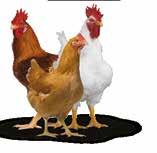











E-mail: victoria@victoria-srl.com
Automatic and digital incubators from 18 to 10.000 eggs of capacity Via G.Galilei 3 – 22070 Guanzate (COMO), Italy Fax: +39-031.899.163
E-mail: fiem@fiem.it




aviagen.com Great Achievements, Great Numbers 2020 - Arbor Acres Zootecnica Magazine Market Guide Ad - ENGLISH.indd 1 2/10/20 1:38 PM Reliable Breeder, Resilient Broiler aviagen.com aviagen.com ROSS 308 DELIVERS Ross Zootecnica Magazine Market Guide Ad - ENGLISH.indd2/10/201 1:34 PM info@cobbvantress.com The Chicken Experts. aviagen.com zootecnicainternational.com Breeders Hatcheries
www.agritech.it – e-mail: commerce@agritech.it
Leader in pig & poultry equipment
Via Roma 29, 24030 Medolago (BG) Italy - Phone +39 035 901240 Fax +39 035 902757 info@azainternational.it www.azainternational.it

CARFED INTERNATIONAL LTD
Italian headquarters: Piazza Oberdan, 3, 20129 Milano (Italy)
Italian warehouse: Via Basilicata, 10, 20098 San Giuliano Milanese (Italy) Tel.: +39 02 9881140 - Fax: +39 02 98280274 Email: carfed@carfed.it - Website: www.carfed.it
UK headquarters: 2nd Floor Gadd House, Arcadia Avenue London, England, N3 2JU, UK Тel.: + 44. 20. 7660.0987- Email: carfed@carfed.co.uk

CODAF Poultry Equipment Manufacturers Via Cavour, 74/76 • 25010 Isorella (Brescia), ITALY Tel. +39 030 9958156 • Fax: +39 030 9952810 info@codaf.net • www.codaf.net
• Watering & Feeding Systems
• Poultry Accessories
• Industry Breeding
• Manure & Egg Belts


Corti Zootecnici Srl | Via Volta 4, Monvalle (VA) - Italy| Tel. +39 0332 799985 | info@cortizootecnici.com
• Turnkey Projects
• Smart Farm System
• Cage-Free and Free-Range Systems
• Poultry Equipment for Layers and Broilers



Via Garibaldi, 54 – 26040 Scandolara Ravara (CR) Italy Tel. (+39) 0375/95135 • Fax. (+39) 0375/95169 info@barbieri-belts.com • www.barbieri-belts.com

www.bigdutchman.de The No. 1 worldwide POULTRY EQUIPMENT BD Ad Zootecnica 55x95 10-13.indd 1 22.10.13 14:24
THE MOST INNOVATIVE RANGE FOR POULTRY FEEDING www.facco.net Officine Facco & C. S.p.A Via Venezia, 30 - 35010 Campo
Italy Phone
S.Martino (PD)
+39 049 9698111 info@facco.net
BELTS
FOR AVICULTURAL US E Manure removal belts an d Manure belt with holes for drying system s
AND ROPES
Equipment
VALLI spa • via Cimatti, 2 • 47010 Galeata (FC) • Italy
T: +39 0543 975 311 • F: +39 0543 981 400 E: info@valli-italy.com • I: www.valli-italy.com
GmbH & Co. KG
Dassendaler Weg 13 • D-47665 Sonsbeck (Germany) T: +49 (0) 2838 912-0 • F: +49 (0) 2838 2791 info@specht-tenelsen.de • www.specht-tenelsen.de
zootecnicainternational.com








Housing equipment for breeders, layers and broilers
www.vencomaticgroup.com

Drinking systems for chicks, broilers, breeders, layers, ducks, turkeys, rabbits and pigs
Conveyor systems for egg collection Climate systems: Pad Climate (evaporative cooling for paper or plastic pads) and Top Climate (with high pressure nozzles)
SISTEM SRL lubingsystem.com
info@lubing.it www.lubingsystem.com
AND NESTING
Via San Lorenzo,9b Campo San Martino (PD) Italy T. +39.049.9620774 - info@flexy.it - www.flexy.it
SRL Via San Lorenzo,9b Campo San Martino (PD) - Italy T. +39.049.9620774 - info@flexy.it www.flexy.it

POULTRY EQUIPMENT MANUFACTURERS
impex
Let’s
about water Flexy
EGG CONVEYORS
LUBING via Marco Polo,
Italy tel. + fax +
nl
talk
SYSTEMS
(Z.I.)
Campodarsego, Padova
Equipment
UPCOMING EVENTS
April, 15 to 17
WPDC
Western Poultry Disease Conference
Salt Lake City, Utah, USA
For information contact: WPDC Foundation
1089 Veterinary Medecine Dr. OFC 4009 Davis, CA 95616
Website: www.wpdcfoundation.org
Venue
Salt Lake City Marriot City Center
220 South State Street
Salt Lake City, Utah 84111
April, 17 to 19
PEAK 2024
Minneapolis Convention Center Minneapolis, USA
For information contact: Midwest Poultry Federation
Tel.: +1 763 284 6763
Email: info@midwestpoultry.com
Venue
Minneapolis Convention Center 1301 Second Ave S, Minneapolis, MN 55403
April, 17 to 19
8th International Conference on Poultry Intestinal Health Manila, Philippines
For information contact: IHSIG vzw
Intestinal Health Scientific Interest Group Knokstraat 38 9880 Aalter, Belgium
Email: info@icpih.com
May, 8 to 10
Fieravicola Africa & Mediterranean Poultry Forum and B2B
2024
Rimini Expo Centre Rimini, Italy
For information contact: Tel.: +39 0547 1877115
Email: info@fieravicola.com Website: www.fieravicola.com
Venue
Rimini Expo Centre Via Emilia, 155 47921 Rimini, Italy
May, 13 to 15
Middle East Poultry Expo
Riyadh International Convention and Exhibition Center Riyadh, Saudi Arabia
For information contact: Website: www.mep-expo.com/en/contact-us
Email: info@mep-expo.com
Venue
Riyadh International Convention and Exhibition Center
King Abdullah Rd, King Abdullah Dt., Riyadh 11564, Saudi Arabia
May, 15 to 16
British Pig and Poultry Fair Birmingham, UK
For information contact:
Karen Sumner, Stand Sales Tel.: 02477 351 045
Email: pigpoultry@rase.org.uk
Alice Bell, Head of Technical Events
Tel.: 07977 499 420
Email: aliceb@rase.org.uk
Website: www.pigandpoultry.org.uk
Venue NEC Birmingham, B40 1NT
June, 19 to 21
AGRI TECH Taiwan
ICC Tainan
Taiwan
For information contact: Informa Markets Asia Ltd, Taiwan Branch
Ms. Sophia Lu
Tel.: +886 2 2738 3898
Email: aat.sales@informa.com
Website: www.agritechtaiwan.com
Venue
ICC Tainan No. 3, Guiren 12th Rd, Guiren District, Tainan City, 11 Taiwan
June, 24 to 28
XVI European Poultry Conference Valencia Conference Center Valencia, Spain
For information contact:
Technical Secretary: Turevents & Go Tel.: +34 963 528 181
Email: info@epc2024.com
Website: epc2024.com
Venue
Valencia Conference Center Avenida Cortes Valencianas, 60 46015 Valencia, Spain
September, 17 to 19
SPACE 2024
Rennes, France
For information contact: SPACE
Rue Maurice Le Lannou
CS 54239
35042 RENNES CEDEX, France
Email: inscription@space.fr
Tel.: +33 (0)2 23 48 28 80 Website: www.uk.space.fr
Venue
Exhibition center of Rennes La Haie Gautrais
35170 Bruz, France
INTERNET GUIDE
Agritech commerce@agritech.it www.agritech.it
Arion Fasoli info@arionfasoli.com www.arionfasoli.com
Aviagen info@aviagen.com www.aviagen.com
Aviagen Turkeys Ltd turkeysltd@aviagen.com www.aviagenturkeys.com
Aza International info@azainternational.it www.azainternational.it
Barbieri Belts info@barbieri-belts.com www.barbieribelts.com
Big Dutchman big@bigdutchman.com www.bigdutchman.de
Biochem info@biochem.net www.biochem.net
Carfed International Ltd carfed@carfed.co.uk
Carfed Italian Branch carfed@carfed.it www.carfed.it
Cobb Europe info@cobb-europe.com www.cobb-vantress.com
Codaf info@codaf.net www.codaf.net
Corti Zootecnici S.r.l. info@cortizootecnici.com www.cortizootecnici.it
DACS mail@dacs.dk www.dacs.dk
EuroTier eurotier@dlg.org www.eurotier.com
Facco Poultry Equipment facco@facco.net www.facco.net
FIEM fiem@fiem.it www.fiem.it
FierAgricola Verona fieragricola@veronafiere.it www.fieragricola.it
FierAvicola info@fieravicola.com www.fieravicola.com
Gasolec sales@gasolec.com www.gasolec.com
Giordano Poultry Plast info@poultryplast.com www.poultryplast.com
GI-OVO B.V. sales@gi-ovo.com www.gi-ovo.com
Hendrix Genetics info@hendrix-genetics.com www.hendrix-genetics.com
Hubbard contact.emea@hubbardbreeders.com www.hubbardbreeders.com
Hy-Line International info@hyline.com www.hyline.com
Impex Barneveld BV info@impex.nl www.impex.nl
Intracare info@intracare.nl www.intracare.nl
Jamesway sales@jamesway.com www.jamesway.com
Jansen Poultry Equipment info@jpe.org www.jpe.org
Lubing System info@lubing.it www.lubingsystem.com
Marel Poultry info.poultry@marel.com www.marel.com/en/poultry
Mbe Breeding Equipment info@mbefabriano.it www.mbefabriano.it
Menci commerciale@menci.it www.menci.it
Meyn sales@meyn.com www.meyn.com
MOBA sales@moba.net www.moba.net
MS Technologies info@mstegg.com www.mstegg.com
Newpharm info@newpharm.it www.newpharm.it
Officine Meccaniche Vettorello luciano@officinevettorello.it www.officinevettorello.com
Omaz srl omaz@omaz.com www.omaz.com
Petersime N.V. info@petersime.com www.petersime.com
Prinzen B.V. info@prinzen.com www.prinzen.com
Reventa info.reventa@munters.de www.reventa.de
Royal Pas Reform info@pasreform.com www.pasreform.com
Roxell info@roxell.com www.roxell.com
Ska ska@ska.it www.skapoultryequipment.com
Socorex socorex@socorex.com www.socorex.com
Space info@space.fr www.space.fr
Specht Ten Elsen GmbH & Co. KG info@specht-tenelsen.de www.specht-tenelsen.de
Sperotto S.p.A. info@sperotto-spa.com www.sperotto-spa.com
TPI-Polytechniek info@tpi-polytechniek.com www.tpi-polytechniek.com
Val-co intl.sales@val-co.com www.val-co.com
Valli info@valli-italy.com www.valli-italy.com
VDL Agrotech info@vdlagrotech.nl www.vdlagrotech.com
Vencomatic Group B.V. info@vencomaticgroup.com www.vencomaticgroup.com
Victoria victoria@victoria-srl.com www.incubatricivictoria.com
VIV Europe viv.europe@vnuexhibitions.com www.viveurope.nl
Editorial Director Lucio Vernillo
Editorial Staff Daria Domenici (zootecnica@zootecnica.it)
Account Executive Marianna Caterino (amministrazione@zootecnica.it)
Editorial Office
Zootecnica International Vicolo Libri, 4 50063 Figline Incisa Valdarno (FI) Italy
Tel.: +39 055 2571891 Website: zootecnicainternational.com
Licence
Registrazione Tribunale di Firenze n.3162 Spedizione in A.P. Art.2 comma 20/B legge 662/96 - Filiale di Firenze ISSN 0392-0593
Subscription Rates (1 year / 11 issues): Europe Euro 100 Rest of the World Euro 120
Subscribe online by Credit Card or Paypal: zootecnicainternational.com/subscription
Subscribe by money transfer: 1. effect a money transfer to: Zootecnica International, Vicolo Libri, 4 50063 Figline Incisa Valdarno (FI) Italy; bank: UNICREDIT, BIC: UNICRITM1OU9 Iban: IT 81 H 02008 38083 000020067507
2. send us your complete shipping address by email: amministrazione@zootecnica.it.
Art Direction & Layout
Laura Cardilicchia – elleciwebstudio.com
Cover Image: © Denise Vernillo
Printed Nova Arti Grafiche, Florence
English Edition Year XLVI April 2024












and latest technical and scientific advances at zootecnicainternational.com! VISIT OUR WEBSITE zootecnicainternational.com FOR A DEEP INSIGHT INTO THE POULTRY INDUSTRY! NEW PRODUCTS COMPANY NEWS EVENTS FIELD REPORTS INTERVIEWS MARKET TRENDS PROFILES
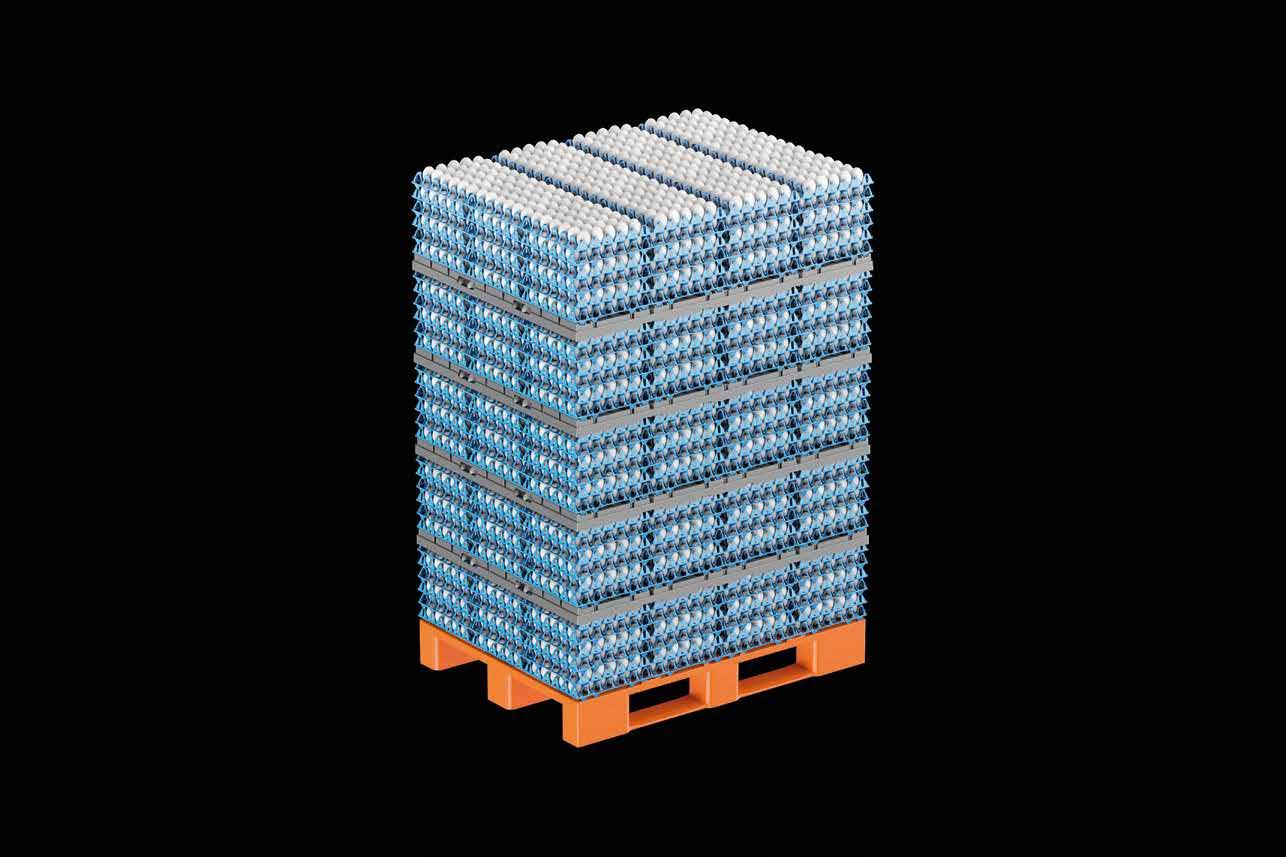


Serving the poultry world better use of space, loss reduction and improved hygiene. www.giordanoglobal.com info@giordanoglobal.com Meet us at stand A11 24-26 April 2024 Meet us at stand 1201B 17 - 19 April 2024







































































































































